FEATURED PIECES
Egyptian Blue Faience figure of a Female Goddess or Concubine.
A Middle Kingdom azure glazed faience figure of a concubine with one hand at her breast. Detailed facial features and broad hips and stomach.
Middle kingdom, circa 11th to 12th dynasty, Circa 2040 to 1782 B.C., Egypt.
From the Nikos Paschalis (1918 – 1948) Collection, inherited in 1965 by his sister, Assimina Paschalis, later by descent to Dr W. Galanos of Melbourne, Australia. Mr Paschalis was the grandson of George Paschalis, the founder of the Paschalion Archaeophylakeion Museum in Samos, Greece in 1912.
H 12.5cm x W 6cm x H on stand 17cm
Decent overall ancient condition. Re-joined at neck, ancient loss evident. Presented on custom display stand.
$9,850
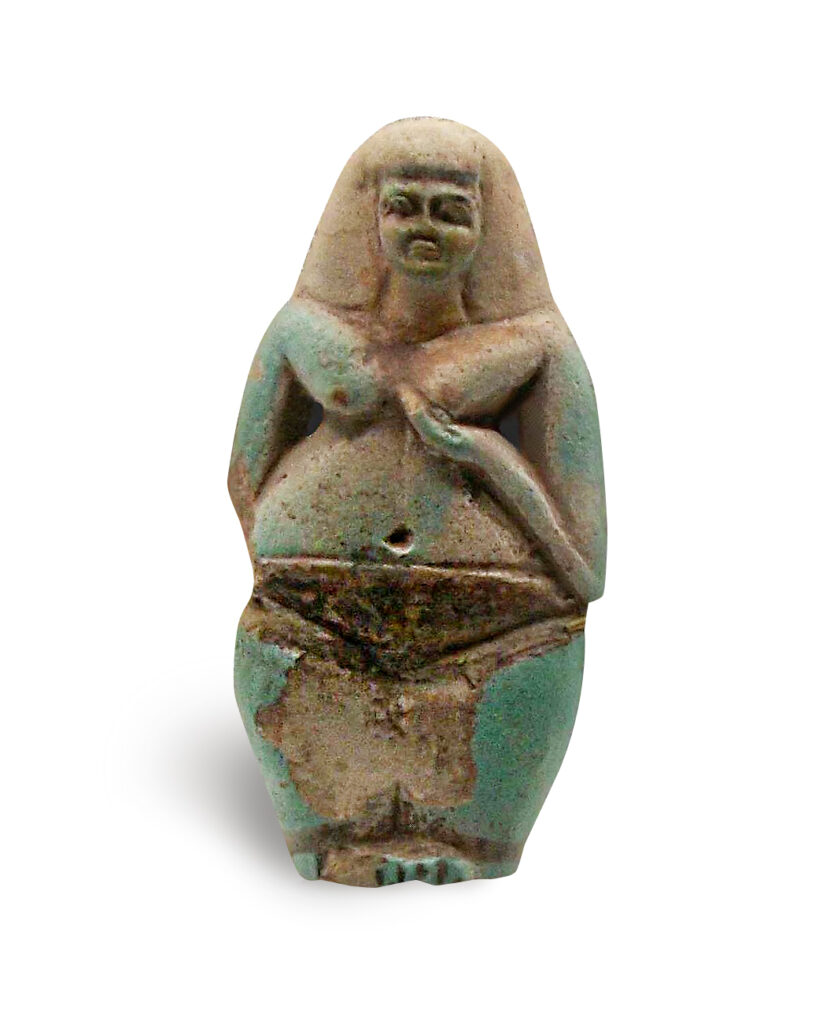
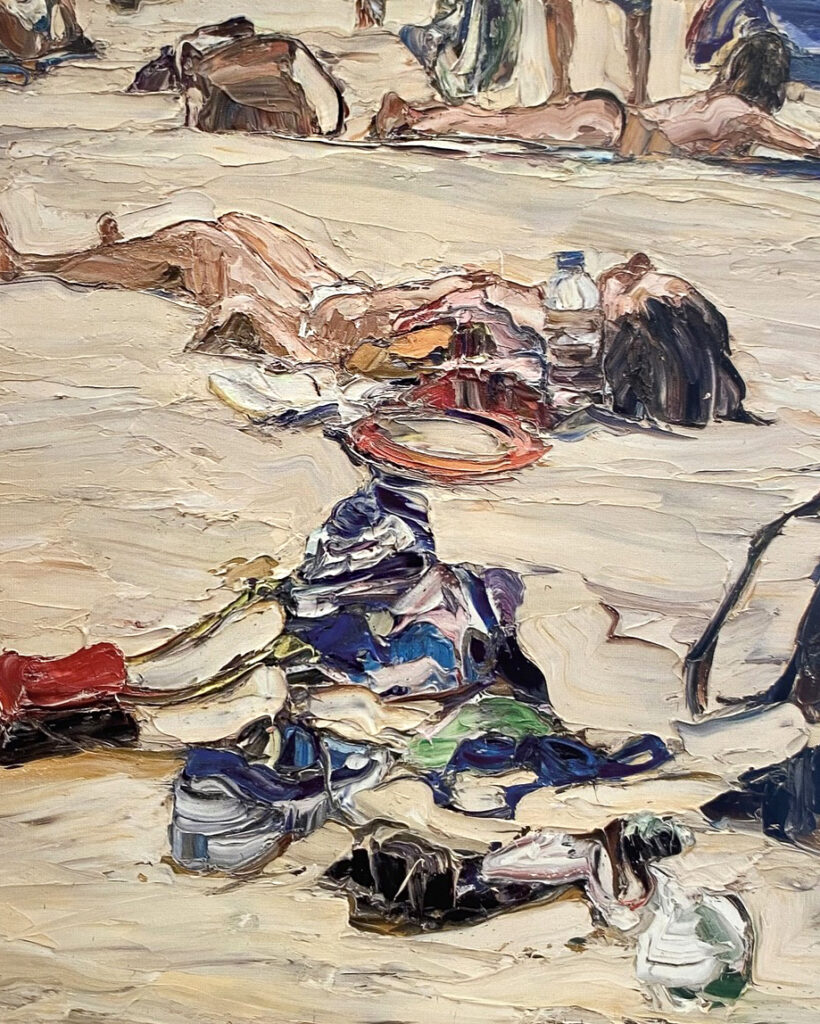
NICHOLAS HARDING
1956 – 2022
Beach Life (frisbee, bags and goggles) 2005
oil on linen, signed, dated and inscribed ‘2005 / Nicholas Harding / BEACH LIFE / FRISBEE, BAGS AND GOGGLES) verso
138 x 122 cm
PROVENANCE
Nicholas Harding, Sydney
Rex Irwin Art Dealer, Sydney (label verso)
Private Collection, Melbourne, acquired from the above
EXHIBITED
Nicholas Harding, Rex Irwin Art Dealer, Sydney, 13 September – 8 October 2005, no. 2 (illustrated on cover)’
$115,000
63JERSEY ART SALES GUEST
Loet Vanderveen (Dutch, 1921 – 2015)
Sitting Panther, c. 1994
Patinated bronze with polished detailing
Signed LOET © 49/1750
The stylised form of a seated panther, cast in dark patinated bronze with a smooth, reflective surface and polished tail accent. Characteristic of Vanderveen’s mature Big Sur period, the sculpture captures the feline’s alert stillness and elegant tension through simplified planes and elongated lines. The incised signature and low edition number indicate an early lifetime casting from a large edition of 1750, produced during the artist’s peak period in the mid-1990s, when he favoured dramatic black patinas to emphasise silhouette and form. “Big Sur period” refers to the decades Vanderveen lived and worked on the California coast, directly overseeing his sculptural output. This is not an estate or posthumous edition.
Provenance: Estate of Mel David Gottlieb
Condition: Excellent overall; even patina with minor surface rubbing consistent with age and handling.
H 31.5cm, L – Tail to Foot Paw 31cm, Base width 11cm; Weight 6.7 kilos.
$1,995
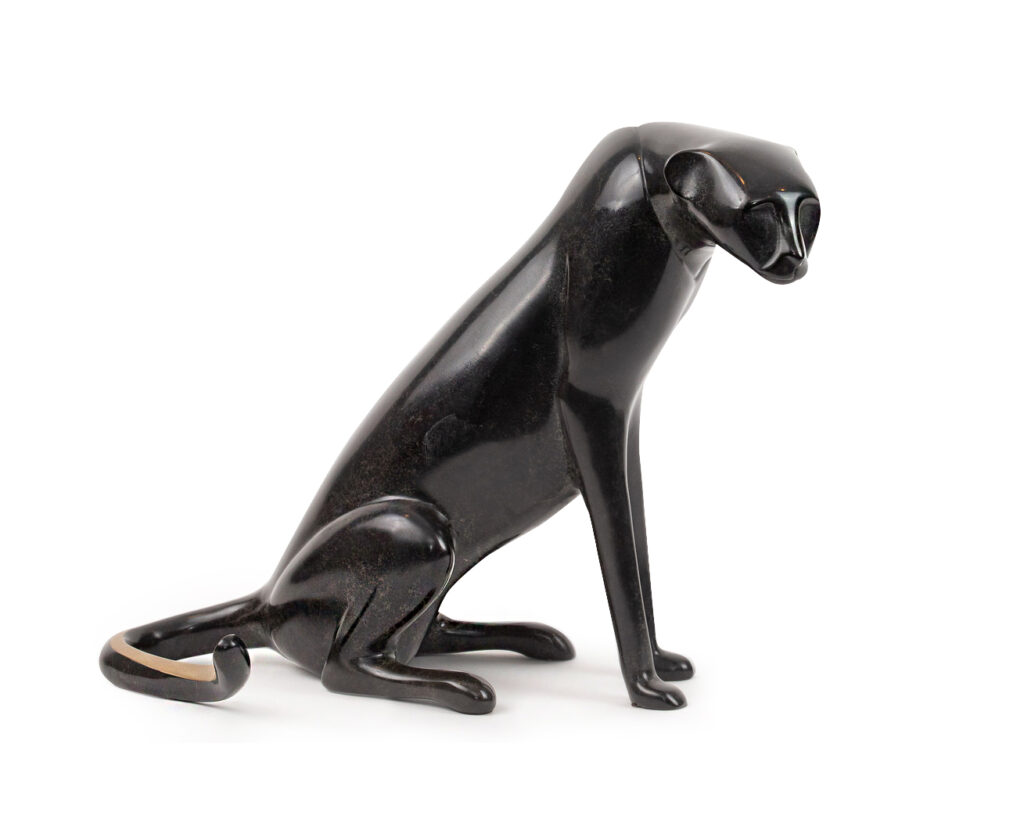
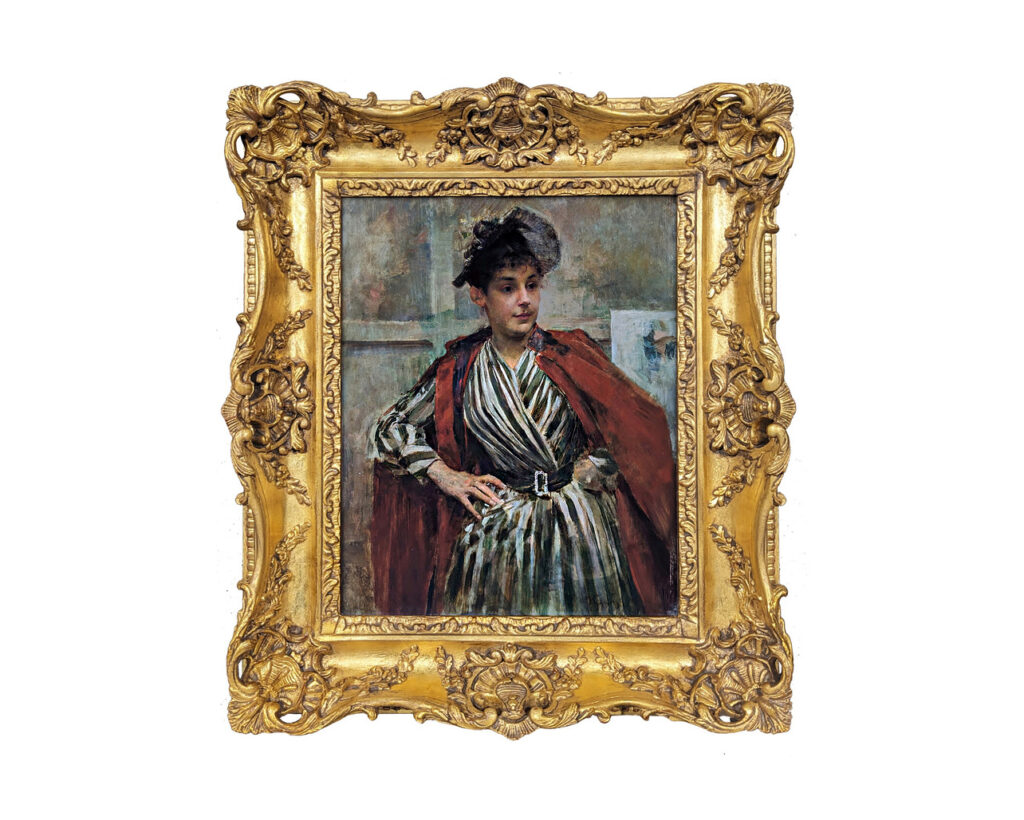
Vojtech Hynais (1854-1925) “The Red Cape”
1890 Czech Republic oil on panel
Vojtěch Adalbert Hynais is a famous, award-winning Czech Painter & founding member of the Vienna Secession. He began studying at the Academy of Fine Arts, Vienna in 1870, under Carl Wurzinger & August Eisenmenger, & at Anselm Feuerbach’s school in spring 1873; he was considered to be one of his most promising students. Hynais lived in Paris from 1878-93, where he learnt from Paul-Jacques- Aimé Baudry & Jean-Léon Gérôme, & was an acquaintance of fellow Czech master, Alfons Mucha. In 1885, he received an honorable mention from the 1885 Universal Exhibition of Fine Arts, and a first-class medal at the 1889 World’s Fair. During the 1870s, art was being produced to decorate the under-construction Prague National Theatre. Hynais was not considered to be suitably representative of the national spirit by Czech art critics because he lived in, & had absorbed too much influence from, Vienna.
H 39.5 x W 31.5cm
Private Collection, Sydney
$150,000
BELLE EPOQUE FINE ART GUEST
An unusual full-sized pale-blue Portland Vase.
The mid-19th century shade of blue is particularly pleasing.
H 25cm. Base 12.8cm. Wedgwood, c. 1860.
$8,000
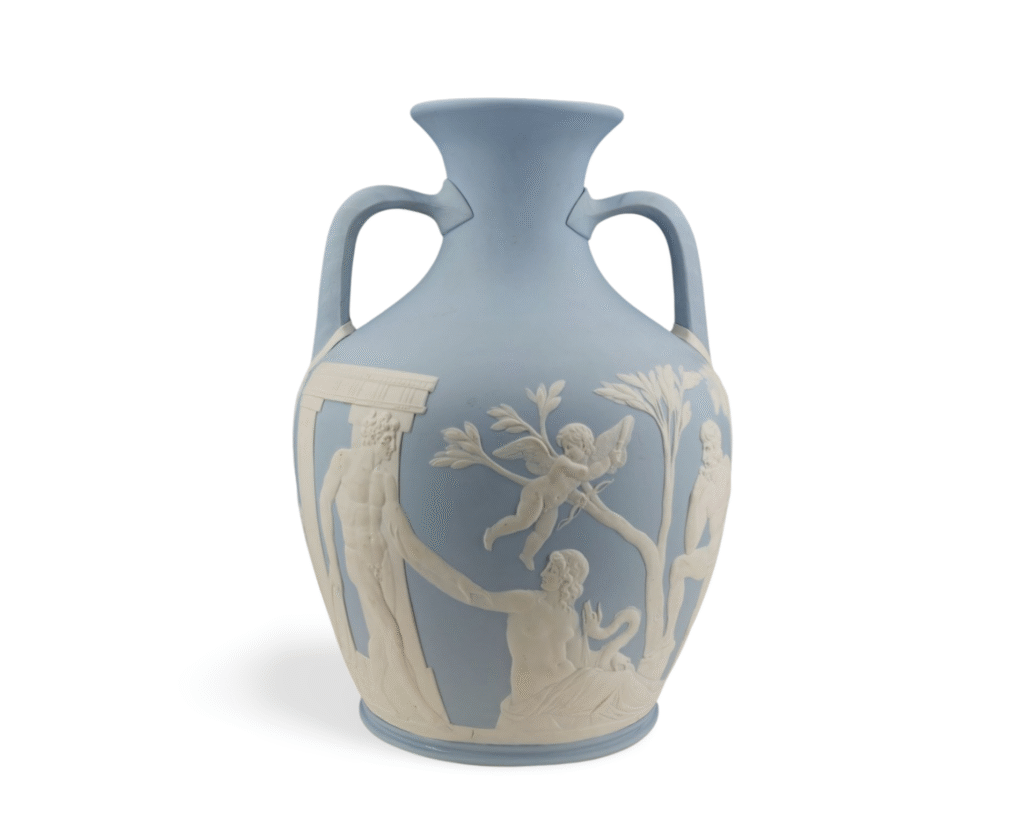
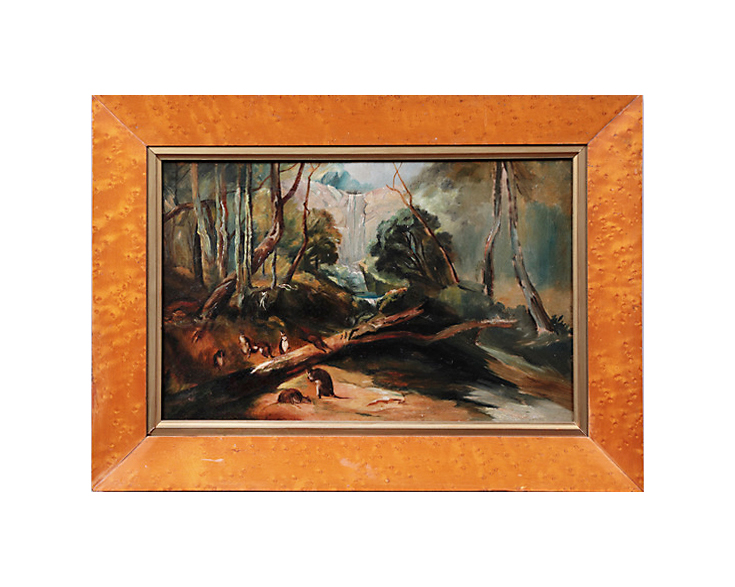
Att. to John Skinner Prout a framed oil on canvas. A study for “Bush Landscape with Waterfall” AGNSW Collection (Bush landscape with waterfall, New South Wales), 1860s by John Skinner Prout
c. 1844-48 H 28cm x D 43cm
$12,500
René Lalique “Ronces” vase
in deep yellow, better known as “butterscotch”, opalescent cased glass, c. 1921, signed on base
H 23cm. Base just under 7 cm.
$14,000
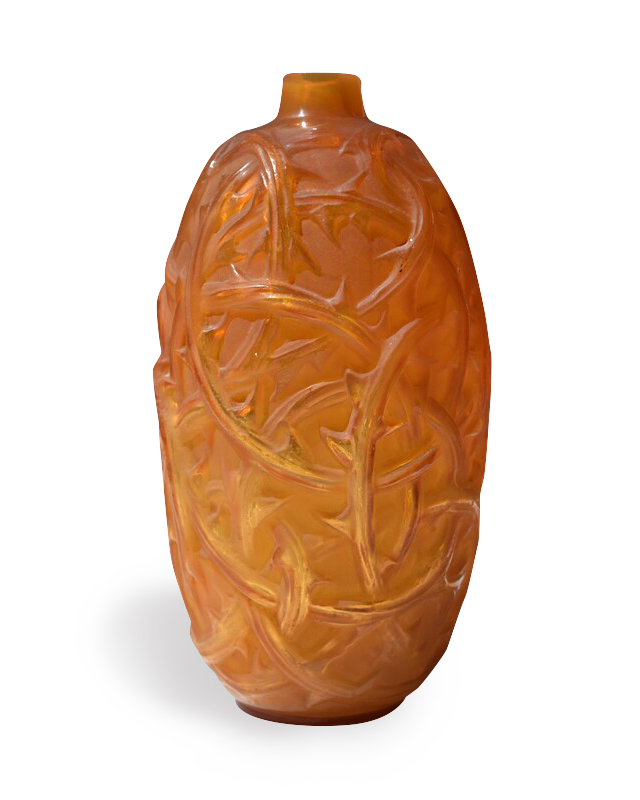
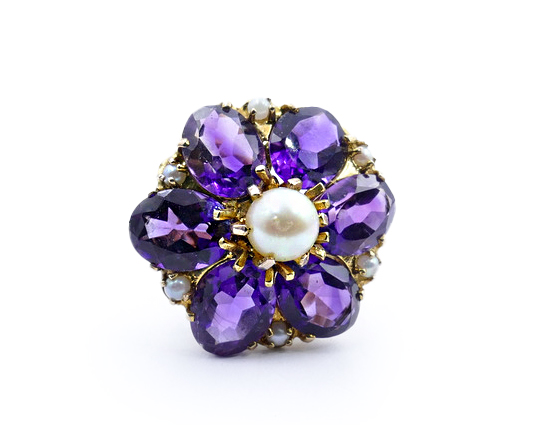
Vintage Amethyst & Pearl flower dress ring in 9ct yellow gold.
Hallmarked – London England 1965.
$4,890
James Northfield 1887 – 1973
Canberra, Federal Capital and Garden City, Australia
c. 1935 Colour Lithography,
H 101.3 x W 63.7cm Linen backed
Text continues “Particulars at Travel and Shipping Agencies. Northfield Studios & J.E. Hackett Poster No. 29. Australian National Travel Association.”
View on the poster featuring Red Hill over the original suburb of Blandfordia 5 [now part of Griffith] toward Black Mountain. The structure framing the view were borrowed from the then completed colonades in 1929, from the Sydney and Melbourne Buildings in Civic Centre. And in the middle of the poster it includes Canberra’s coat of arms and the motto on it means: For the King the Law and the People.
This is one of the rarer key posters of Canberra from its time as the city was being developed.
$6,600
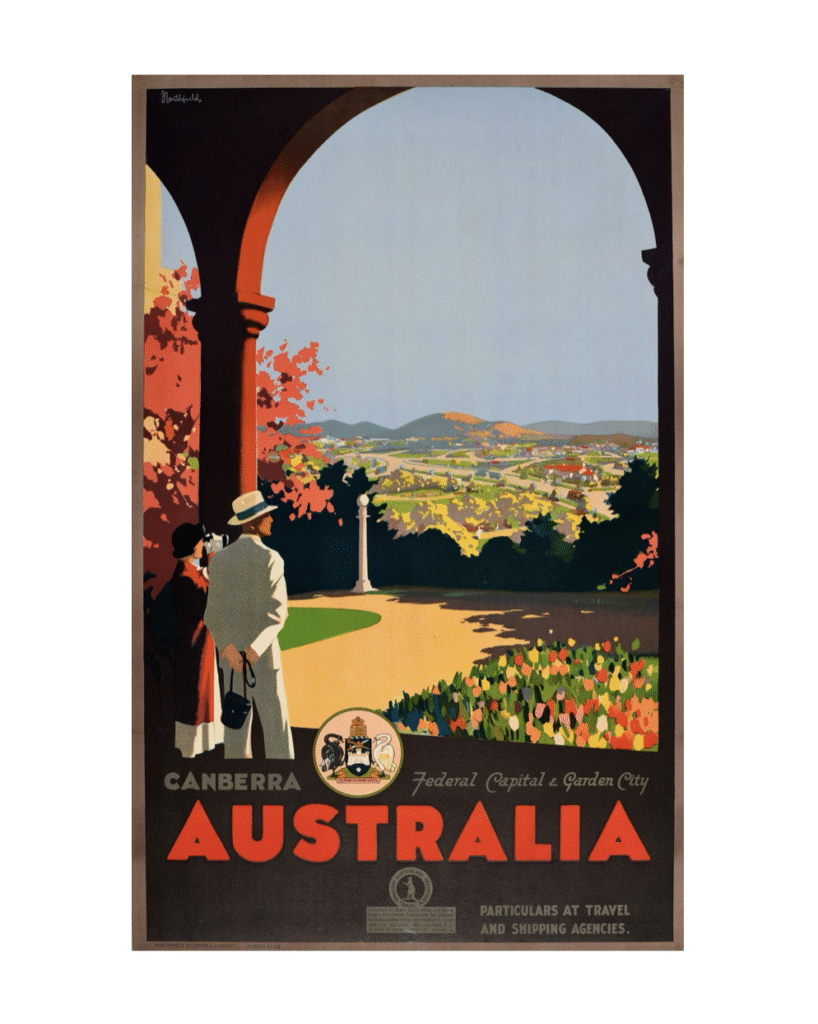
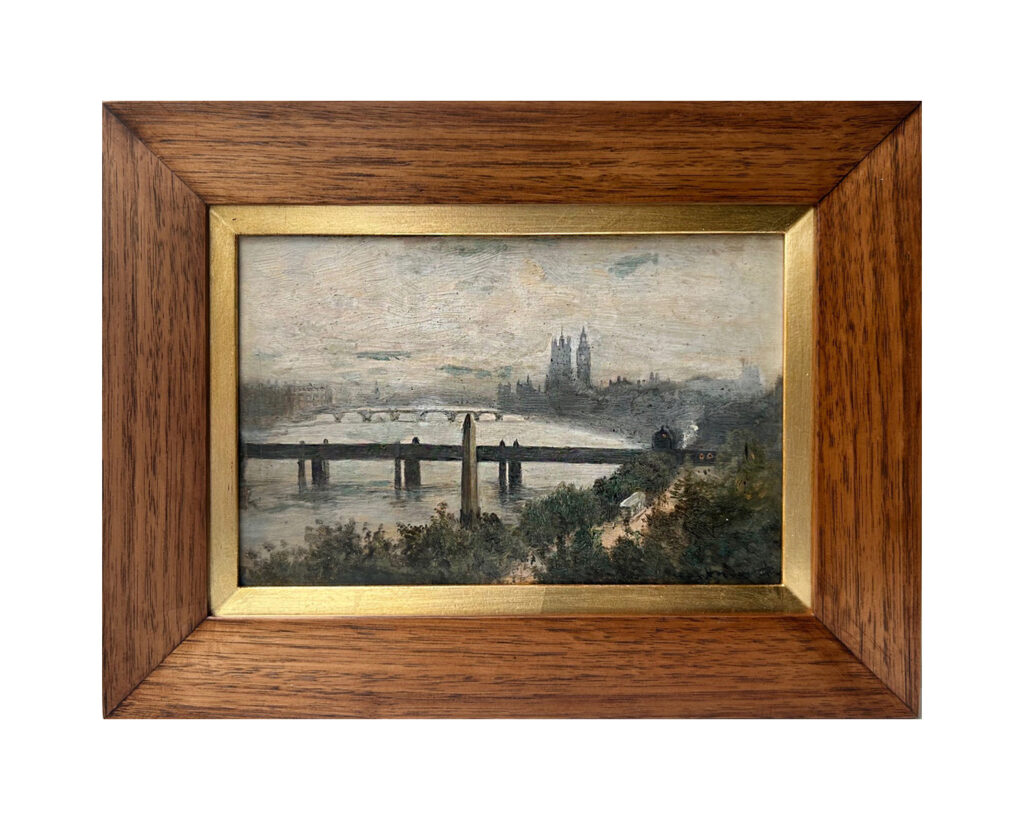
GEORGE HYDE POWNALL
1866 – 1939
Westminster from the Savoy c. 1910
oil on artistboard
15 x 23.3 cm
signed lower right
$4,500
GEORGE HYDE POWNALL
1866 – 1939
St James’ Palace Gateway c. 1910
oil on artistboard
23.3 x 15.3 cm
signed lower right
$4,500
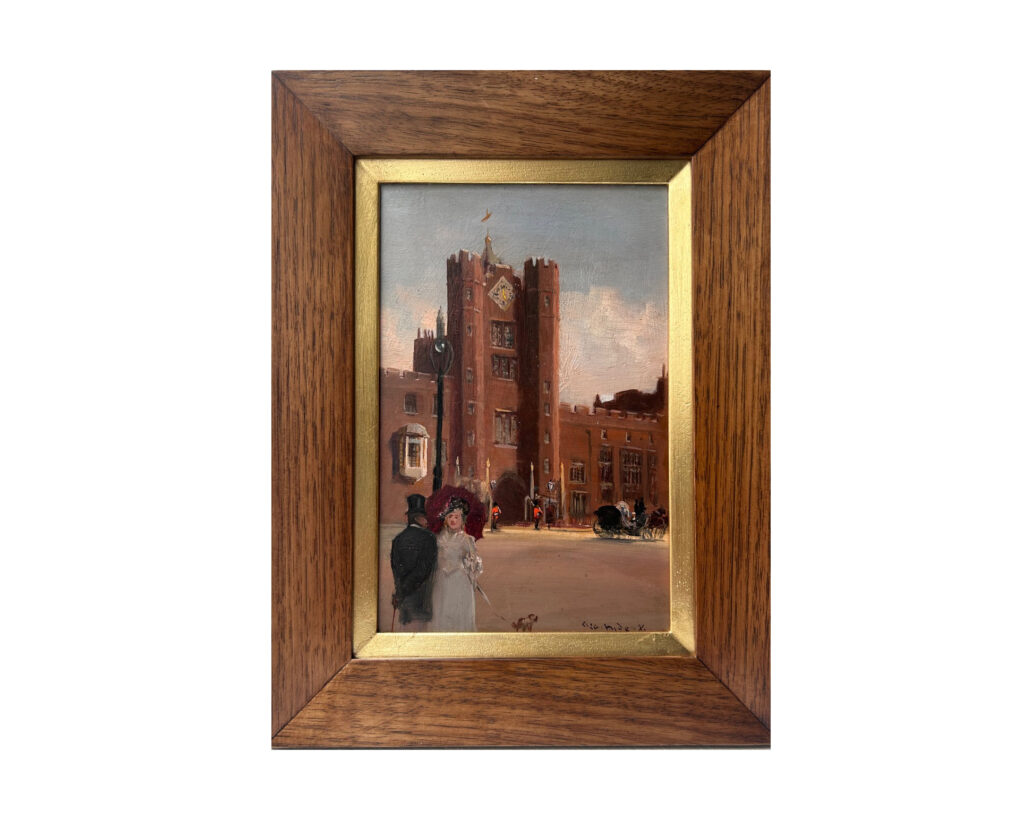
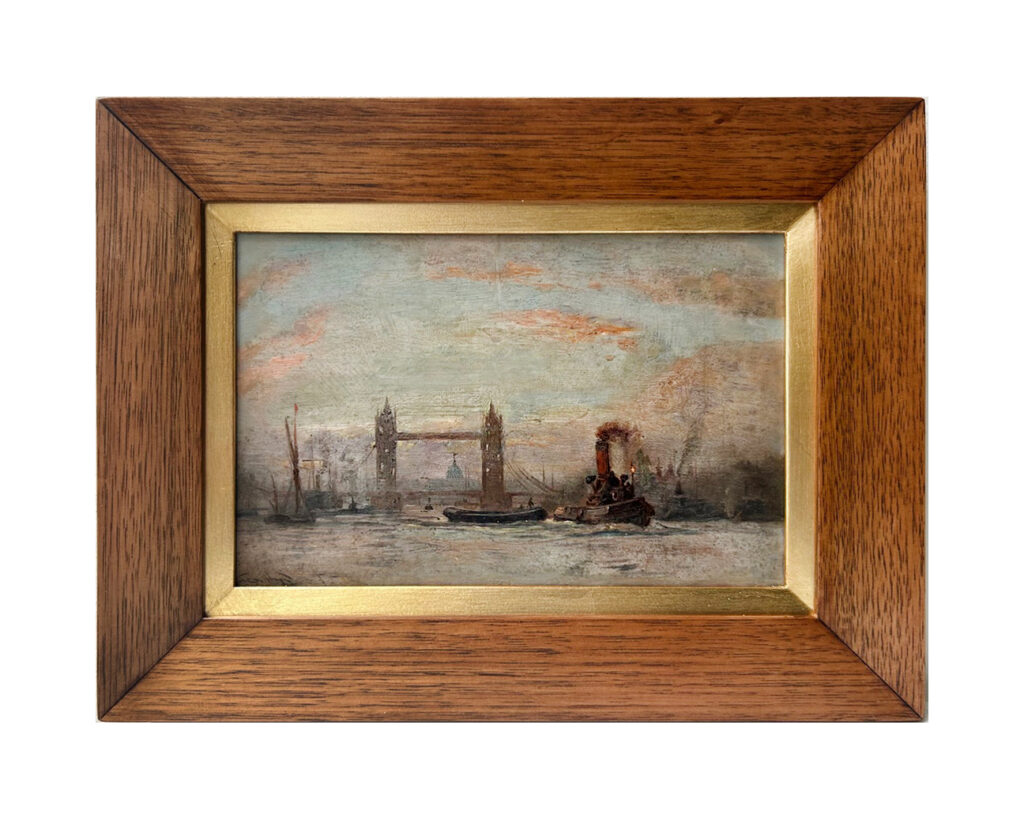
GEORGE HYDE POWNALL
1866 – 1939
Tower Bridge c. 1910
oil on artistboard
15 x 23.3 cm
signed lower right
$5,500
GEORGE HYDE POWNALL
1866 – 1939
The Tower of London from London Bridge c. 1910
oil on artistboard
15 x 23.3 cm
signed lower right
$4,500
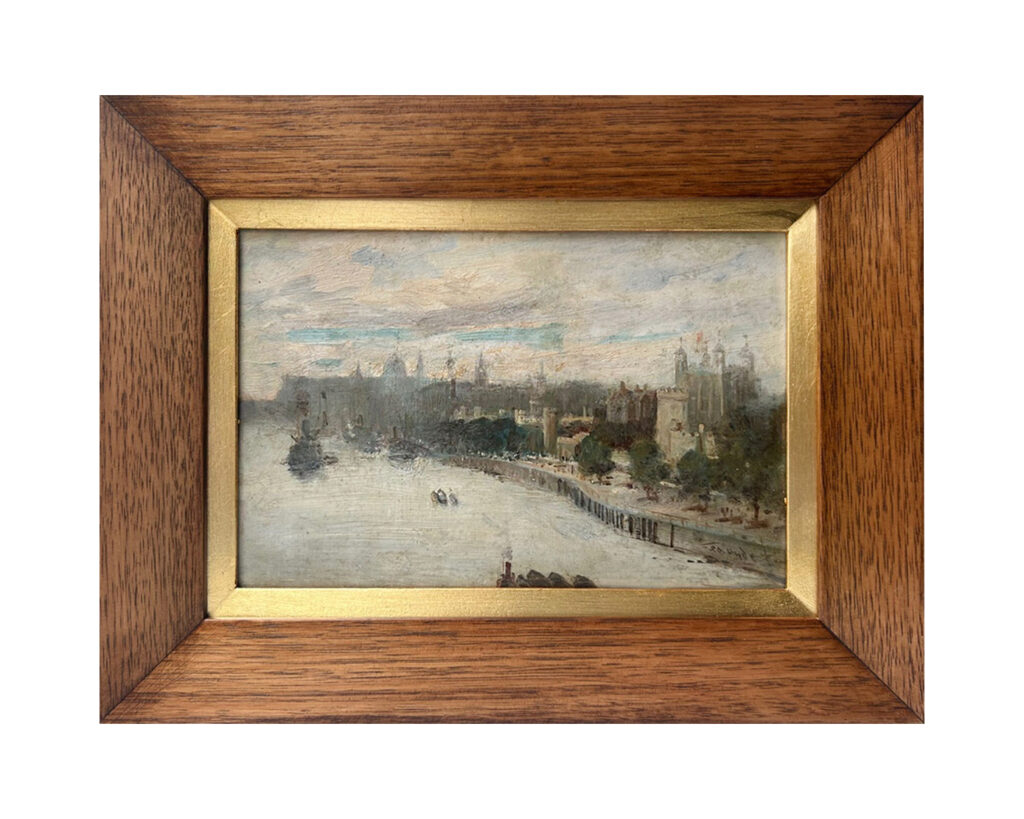
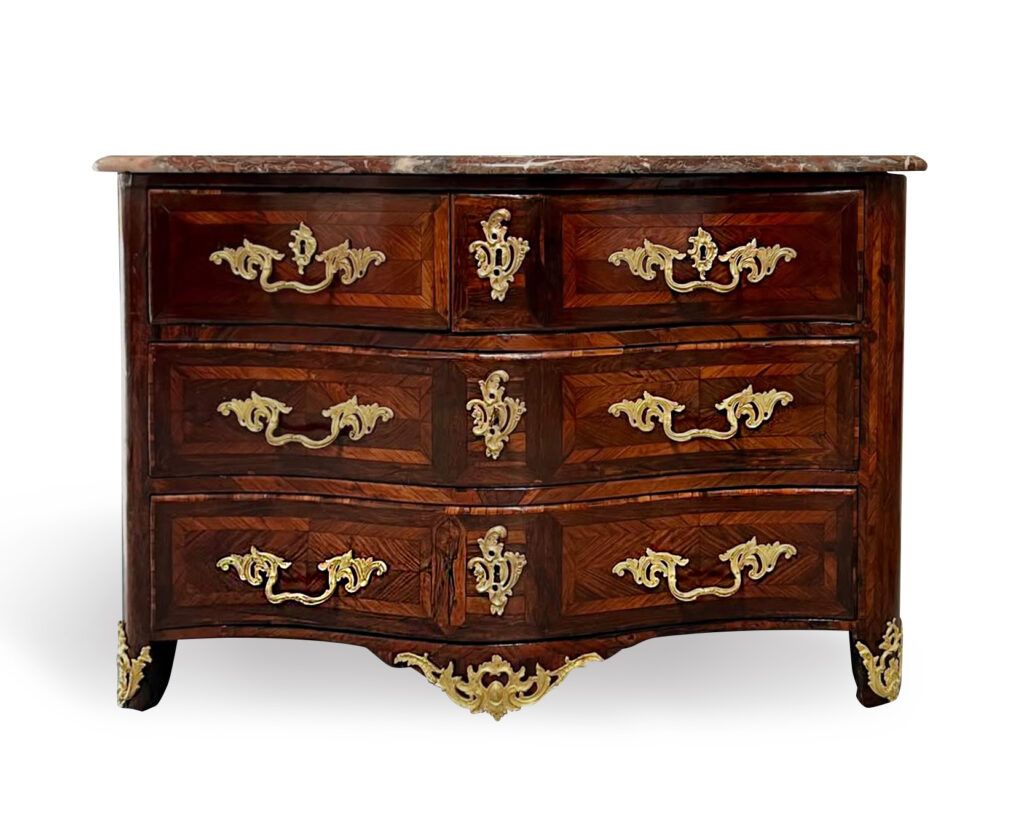
An Important French Régence Commode, c. 1720. Stamped with the cabinet maker’s name MONDON François.
I have recently restored this commode which is in excellent condition. The commode is in Rosewood veneers with original gilded bronze handles and mounts and has a Rouge marble top.
François Mondon (1694-1770): This 18th-century cabinetmaker came from a family of artisans from Dauphiné who were scattered throughout various regions of France and abroad. He was a leading specialist in Regency-style chests of drawers. One of the most important and renowned cabinet makers of the time in Paris France. His pieces are exhibited in many museums and are highly sought after.
Museums: Palace of Versailles
Museum of Decorative Arts – Lyon
Museum of Decorative Arts – Paris
W 1310mm x D 660mm x H 810mm
$28,000
Australian 9ct gold Opal bracelet, c. 1930, featuring reds blues and greens
Opal H 3cm x W 1.5cm
$9,900
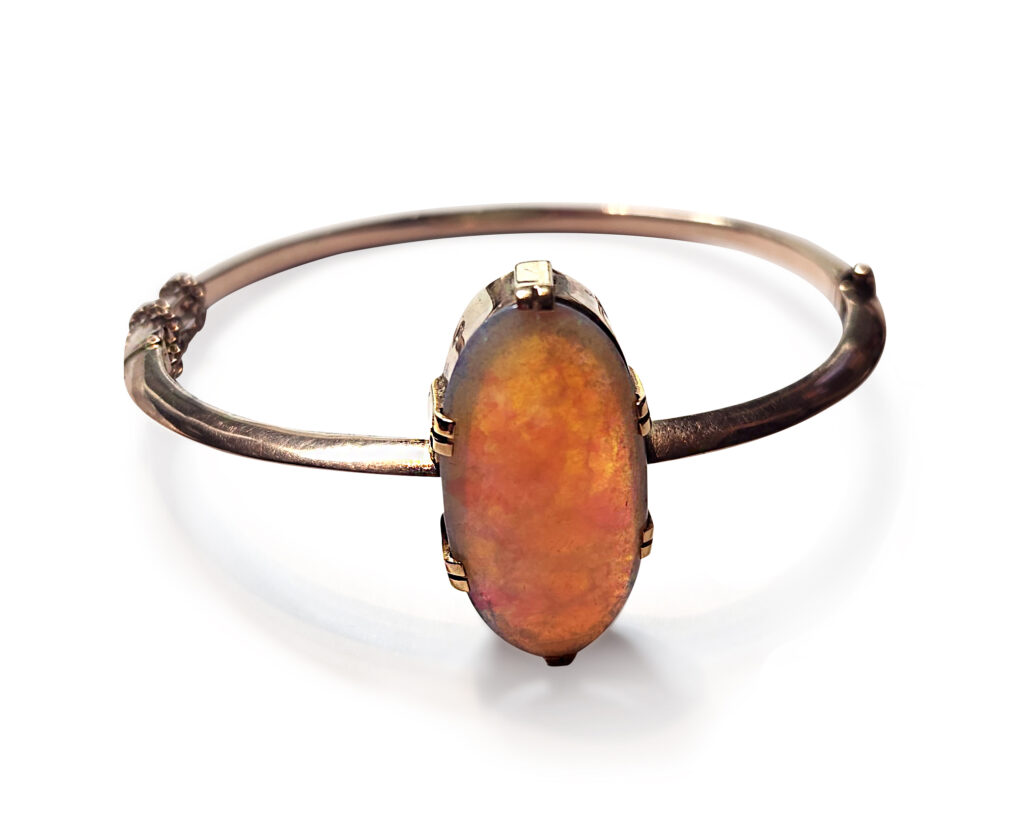
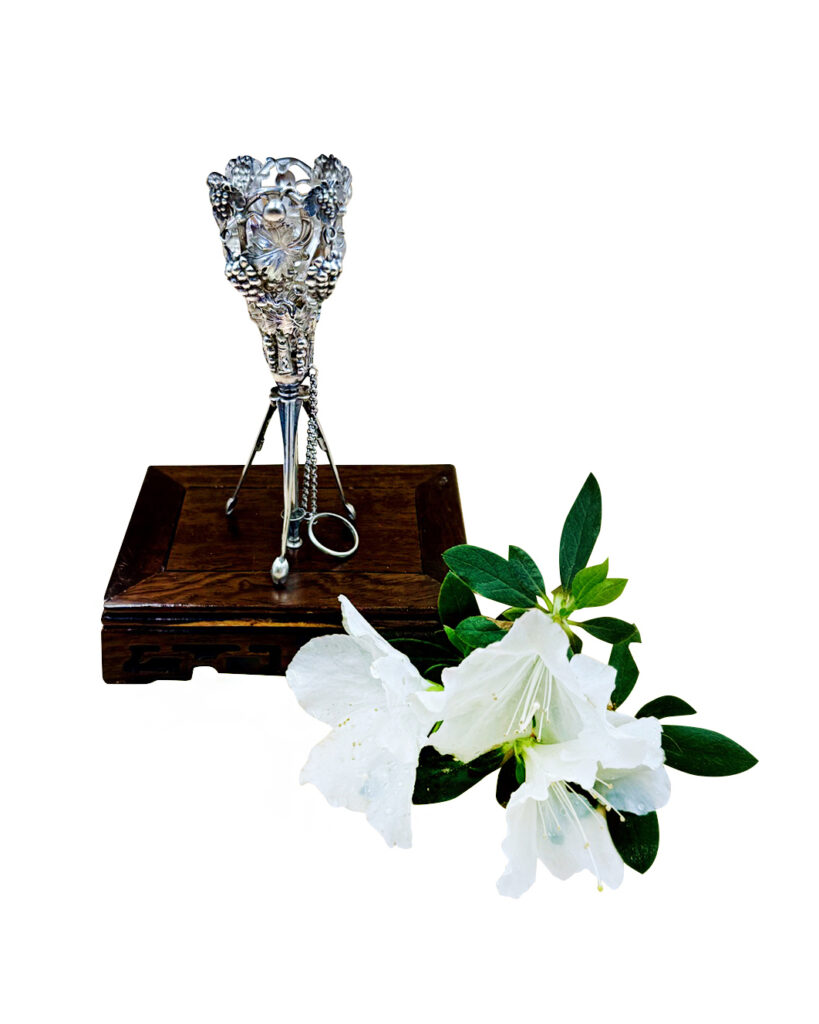
Ornate silver plate standing posy holder
English circa 1880
H 12.5cm D 4.5cm
$550
Qashqa’i Kilim Southern Persia, circa 1880, ‘Comb’ Design.
L 297cm x W 148cm
$8,000
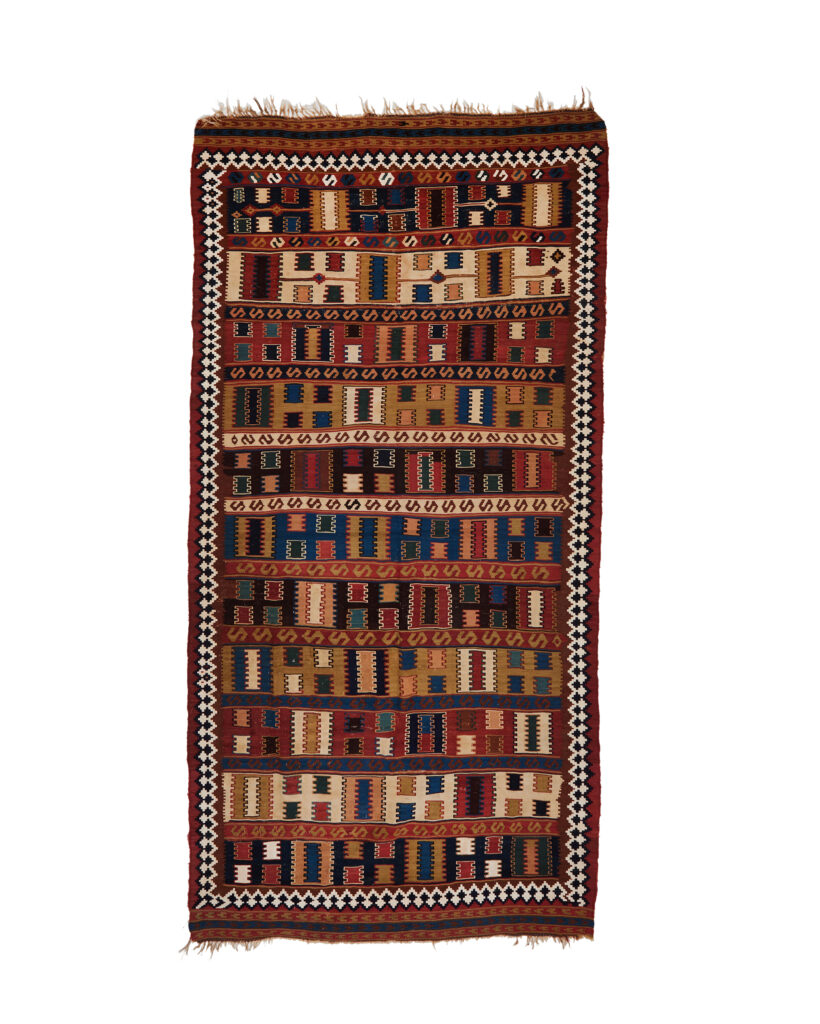
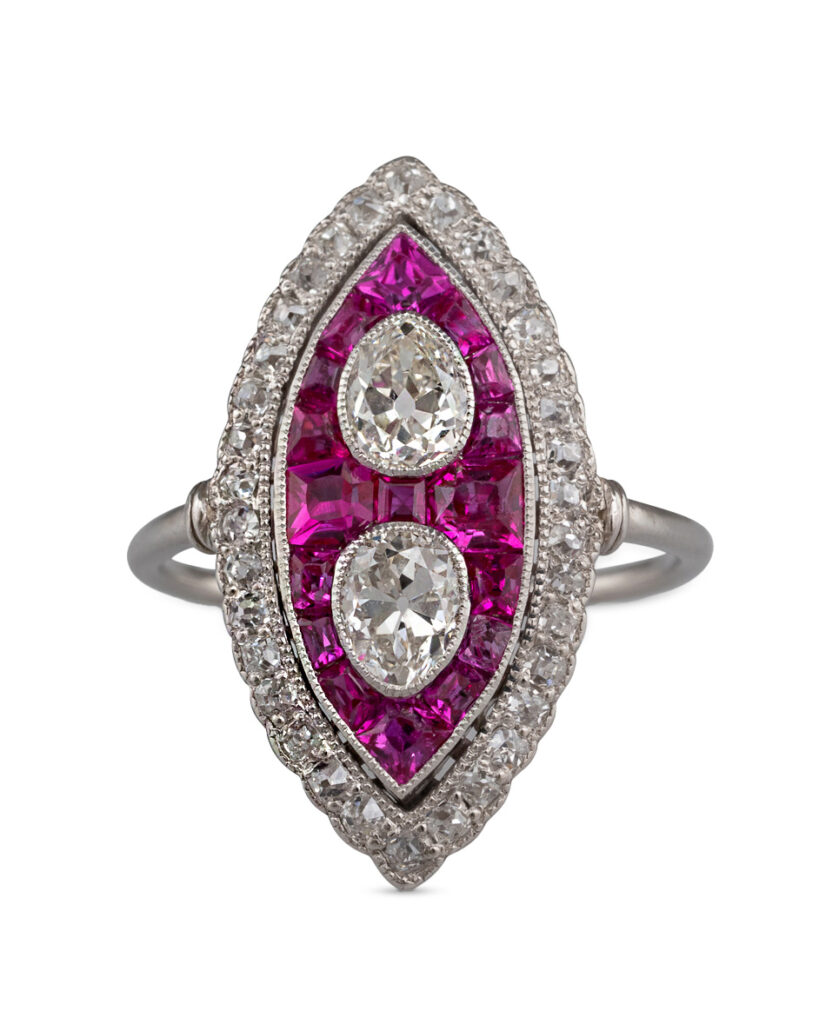
Platinum navette shaped plaque ring with millgrain edge, bezel set to the centre with two pear cut diamonds of total estimated weight 0.70ct, graded as colour I-J, clarity VS-SI, surrounded by channel set calibre cut rubies and grain set to the outer surround with mixed old cut diamonds, all held in a pierced backplate and on a high domed half round band.
French, Circa 1910.
Size P approximately (Can be resized)
Total Estimated Diamond Weight: 1.21ct
Weight: 5.2grams
$18,800
Swiss 19th century 14 carat gold snuff box, c. 1870.
W 7.5cm x D 5.8cm x H 1.5cm 82.8 grams
$12,500
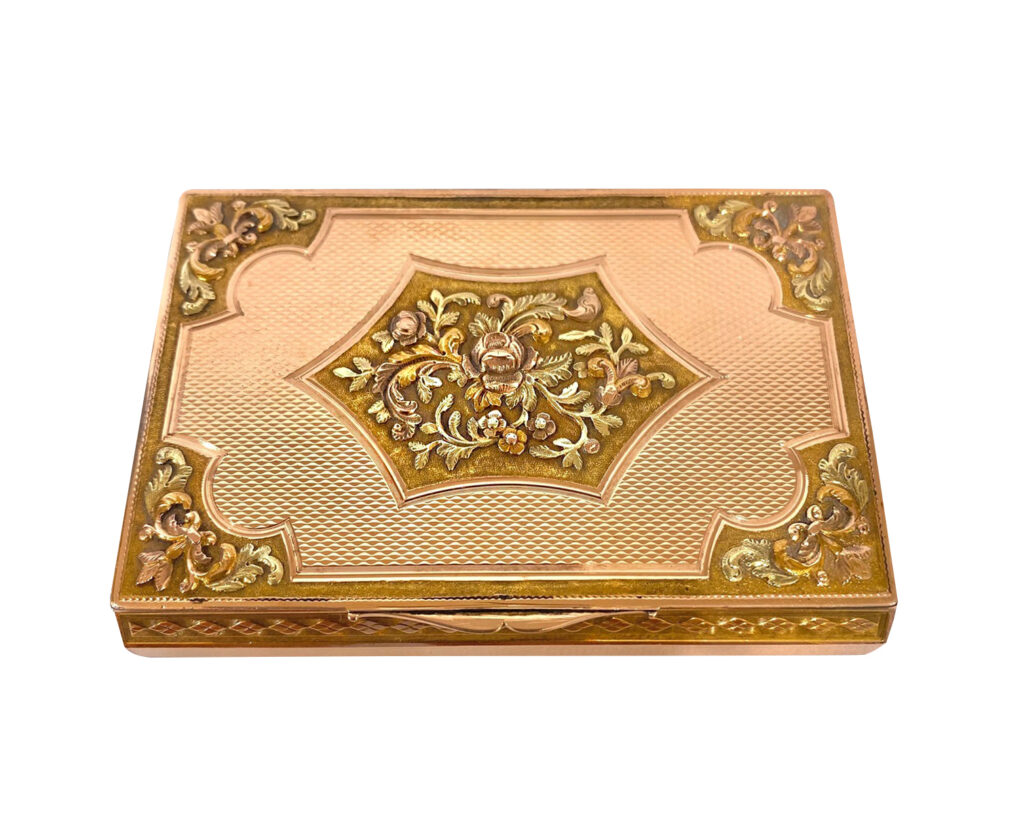
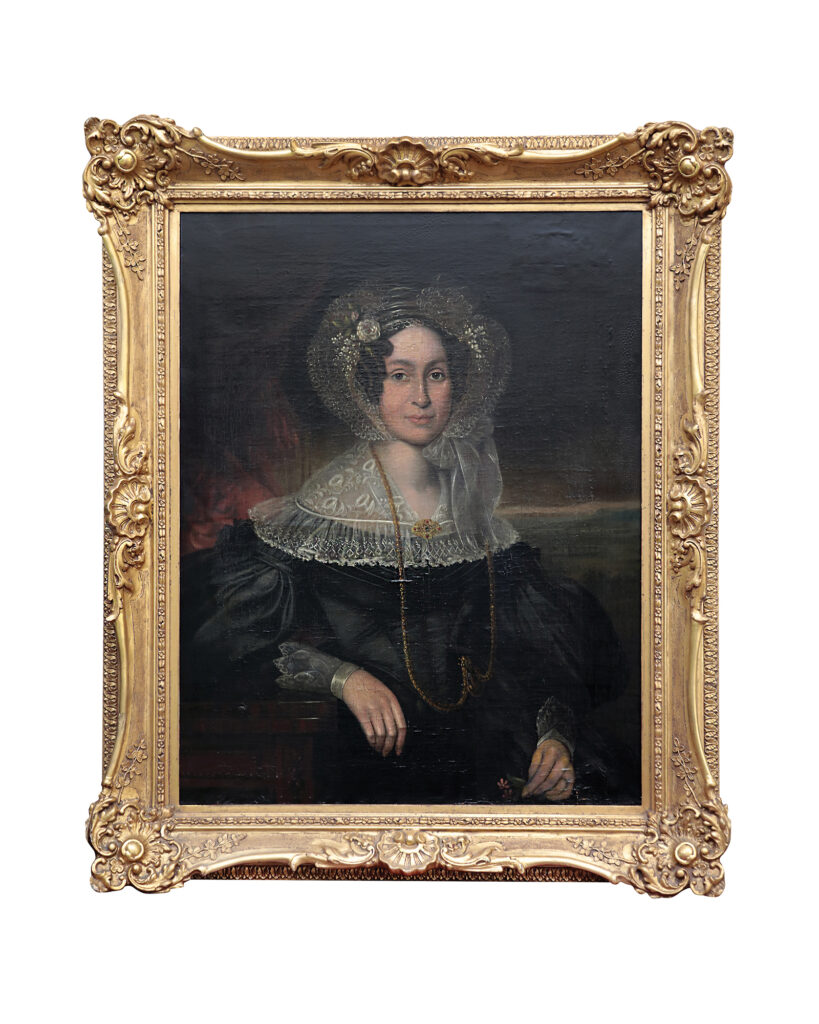
A Colonial-era Portrait of a woman wearing an indoor cap and ornate gold Jewellery, in an attractive gilt frame, probably Australian c. 1840
H 89 x W 69cm
$13,500
Vintage Georg Jensen Sterling Silver Lotus Necklace Nanna and Jorgen Ditzel c. 1965
A rare original solid silver necklace of two staggered layers of six edge to edge curved petals joined with oval links and finished with an integrated box clasp closure – marked 925 for Sterling silver and with post 1945 marks for Georg Jensen of Copenhagen along with design number 129 and Monogram for Nanna and Jogen Ditzel and known as the Lotus Necklace designed 1961 – c. 1965 Denmark.
Notes: this necklace is from the original edition: a limited archive release was made in 2020.
$12,500
ANTIQUES-ART-DESIGN
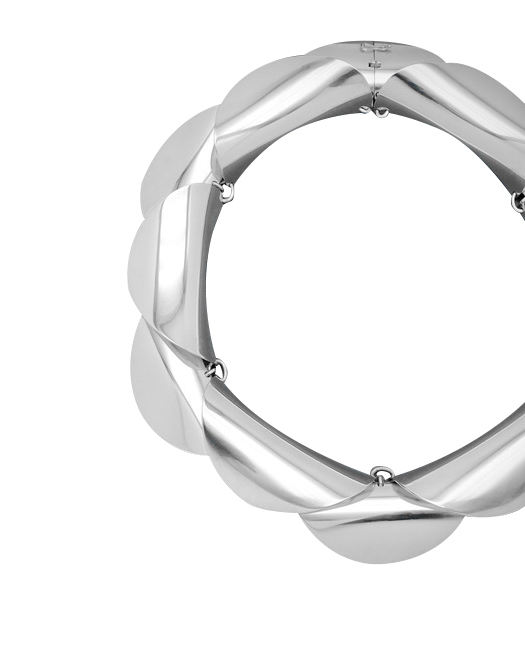
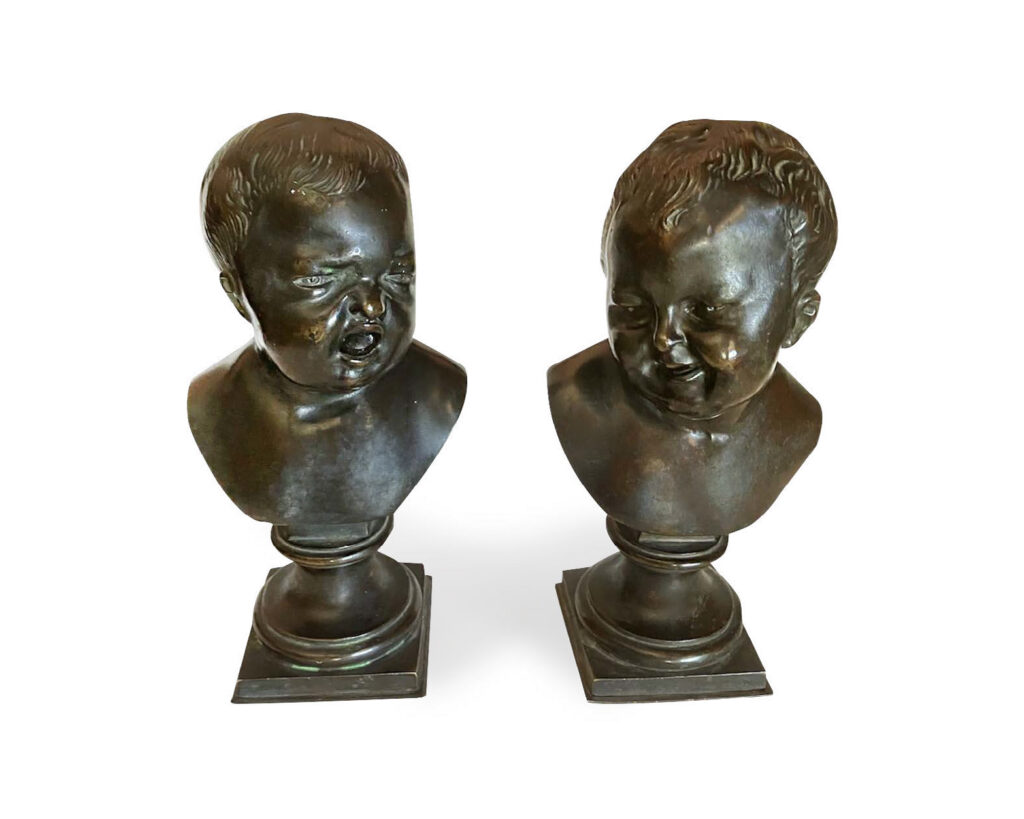
French Napoleon III pair of bronze statues, “Jean who laughs and Jean who cries” after Jean-Antoine Houdon, c. 1850 Originally interpreted from an 18thC poem by Voltaire embodying the versatile nature of humanity from happiness to sorrow.
H 20cm x W 10cm x D 8cm.
$2,750
SHAWBROOK ANTIQUES
Large Pair of French Porcelain Jardinieres.
Decorative porcelain planters meant to hold a potted plant.
These have hand painted floral decoration, green glazed interiors, and gilt bronze/ormolu mounts with ring handles and footed bases, c. 1890.
H 34cm x D 29cm
$4,500 pair
WOODSHED ANTIQUES
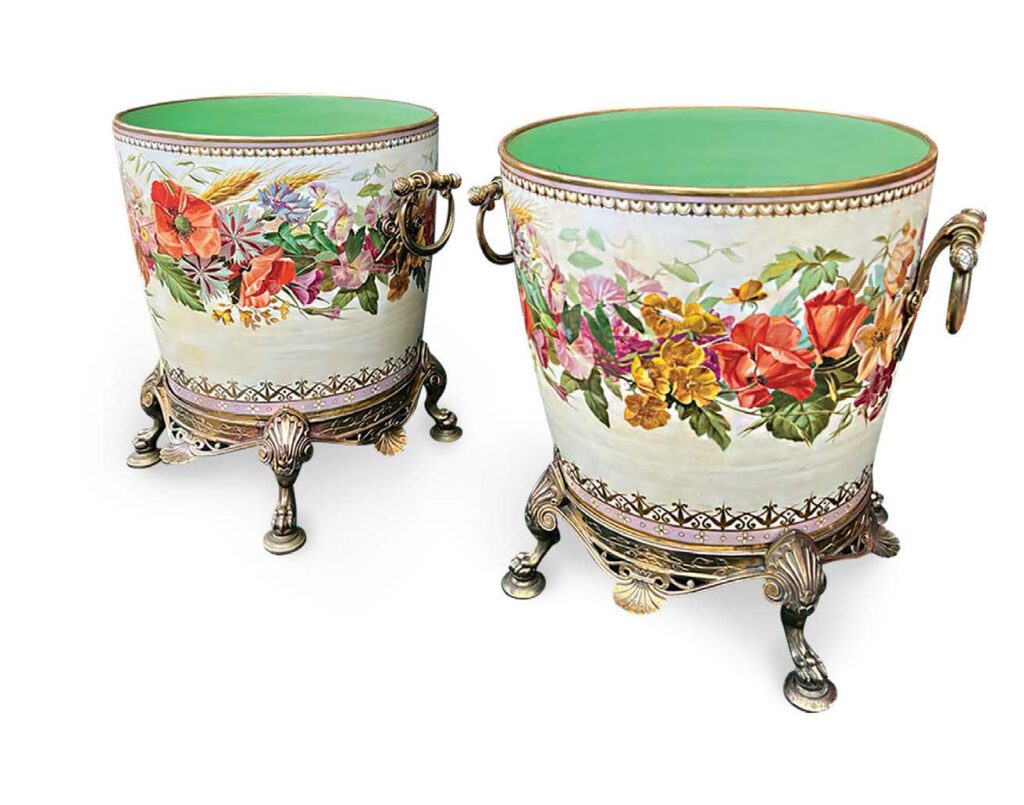
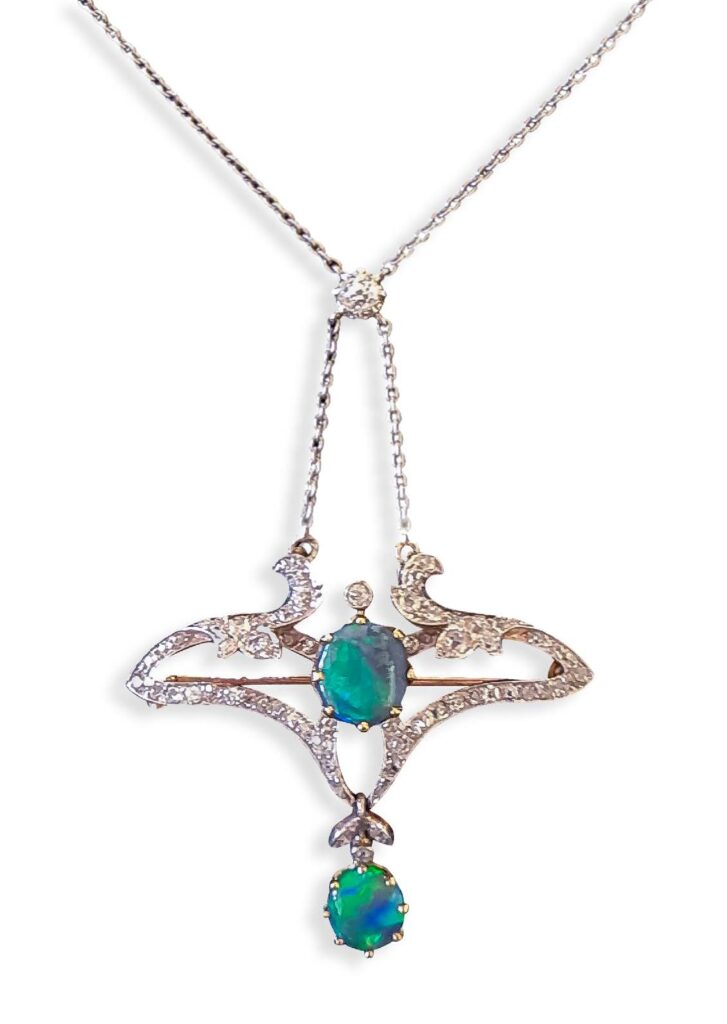
18ct gold & platinum set Art Deco
Black opal and Diamond pendant.
English c. 1925.
50mm x 22mm
$15,595
TRINITY ANTIQUES
English Regency Zebrawood Grecian secretaire, c. 1810
A superb and rare English Regency Grecian writing cabinet in richly figured zebrawood, with ebony, goncalo alves, and a beautifully fitted West Indian satinwood interior. This exceptional piece embodies the refined neoclassical taste of early 19th-century London craftsmanship. The upper section features glazed
doors enclosing adjustable shelves which is fully lined with the original royal blue velvet. The lower fall-front secretaire reveals a finely detailed satinwood interior with drawers, pigeonholes, and its original inkwells and keys intact. The secretaire desk top is adorned with its original tooled leather top in antique green with gilt keywork. The cabinet is further enriched by original ormolu mounts of exquisite quality—hallmarks of the best Regency period design. Lionhead knockers flank either side of the secretaire front. Gilt bronze half columns decorate both sides and the writing cabinet rests on ball feet. This secretaire is attributed to George Oakley, one of London’s most innovative and fashionable cabinetmakers of the period, celebrated for his bold architectural forms and rich use of exotic veneers. It belongs to a small, highly sought-after group of architectural ormolu-mounted zebrawood writing cabinets, closely related to examples held in the Victoria and Albert Museum, London, and the Museum of Fine Arts, Boston.
An outstanding example of Regency opulence and craftsmanship— where symmetry, exotic timbers, and gilt-bronze ornamentation unite to stunning effect.
Ex Collection of Lord Wedgwood
H 163cm x W 79cm x D 48cm, open D 82cm
$39,500
VALENTINE’S ANTIQUE GALLERY
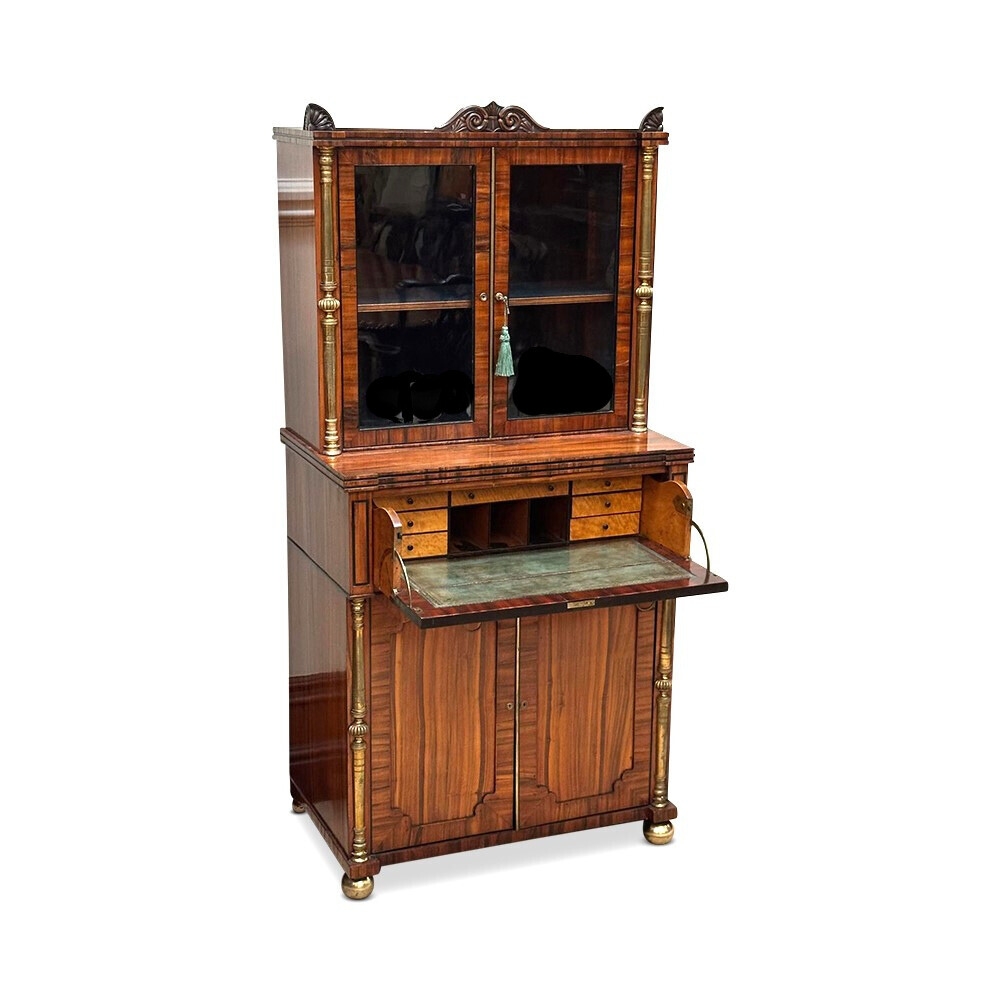
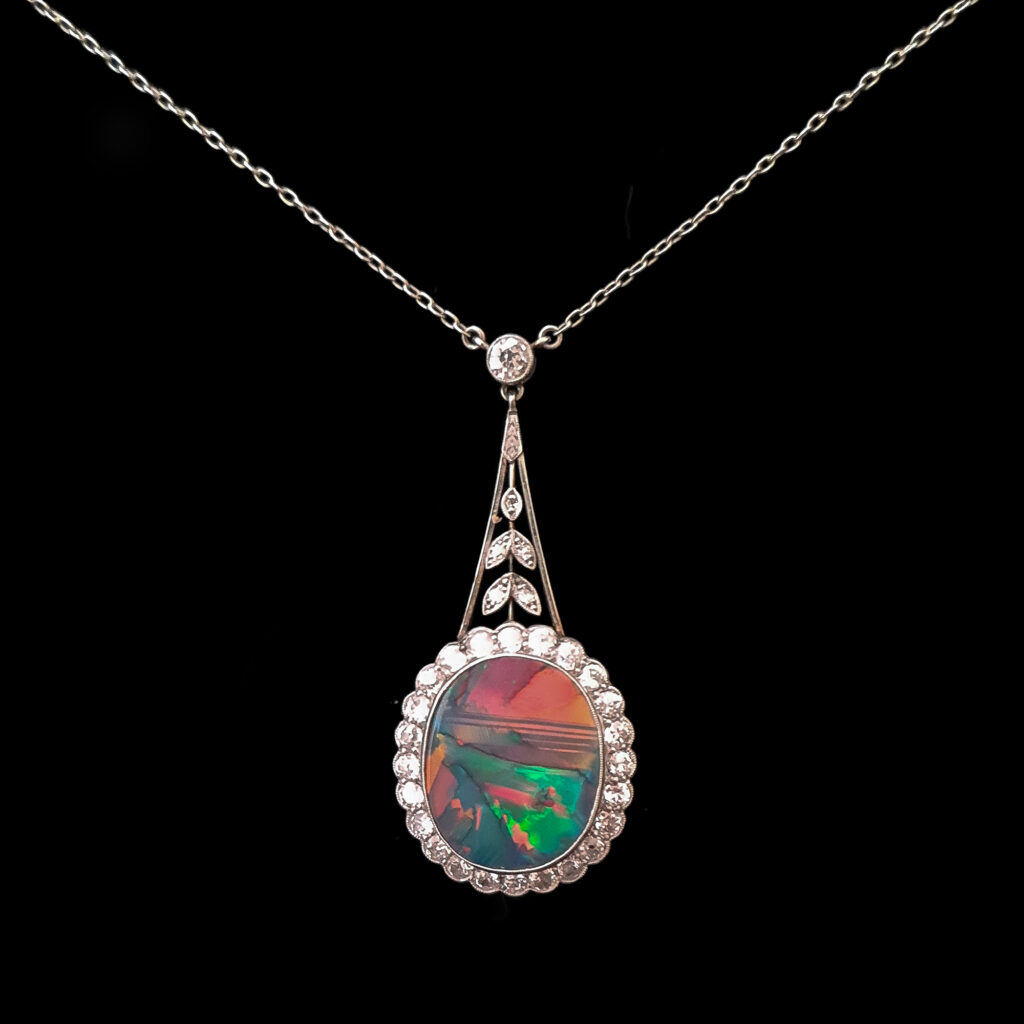
18ct gold & platinum set Art Deco Black opal and Diamond pendant.
English c.1925
H 50mm W 22mm
$45,500
TRINITY ANTIQUES
Late George 11 / early George 111 period mahogany & gilt gesso bureau bookcase, retaining its original mercury silvered mirror plates and having secret compartments. c. 1750-60. Attributed to Gillows of Lancaster and London
W 1.09m x D 0.59m x H 2.07m
$15,985
LAUDER & HOWARD ANTIQUES
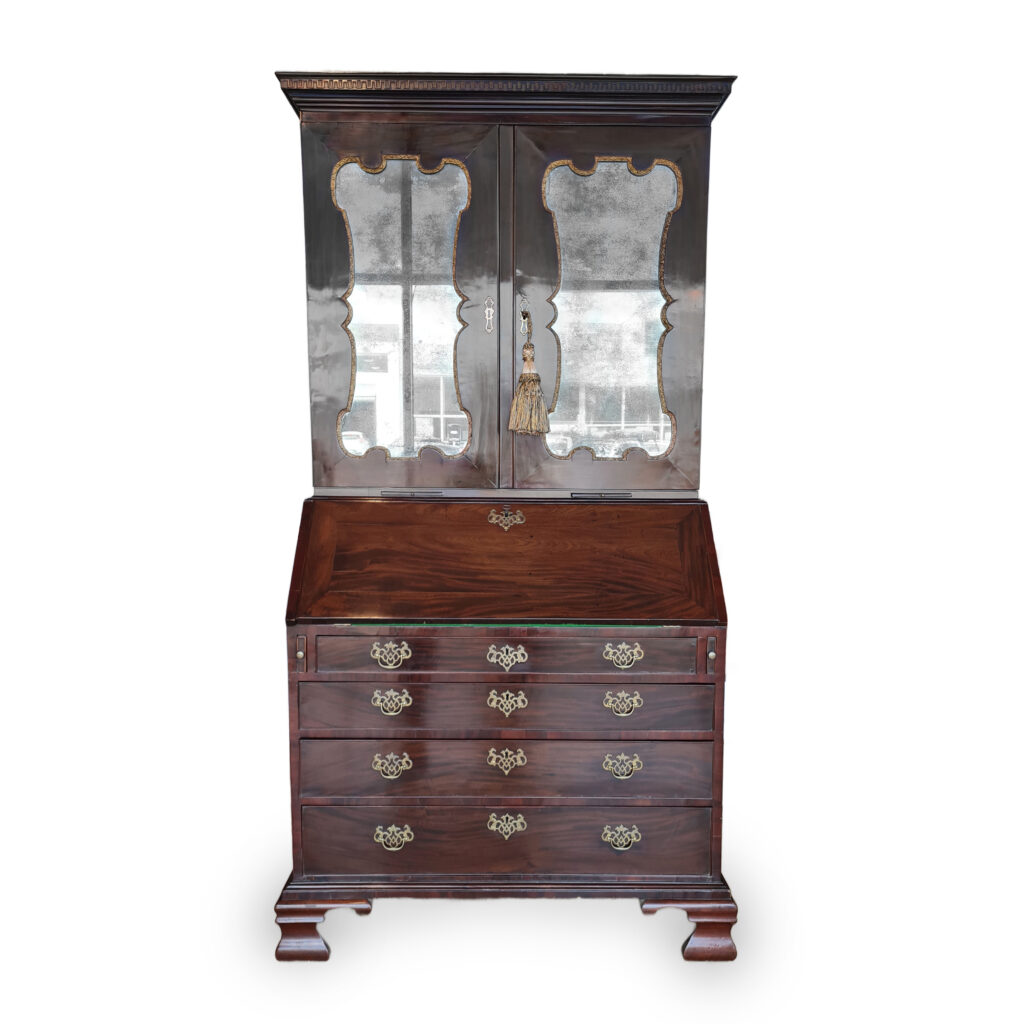
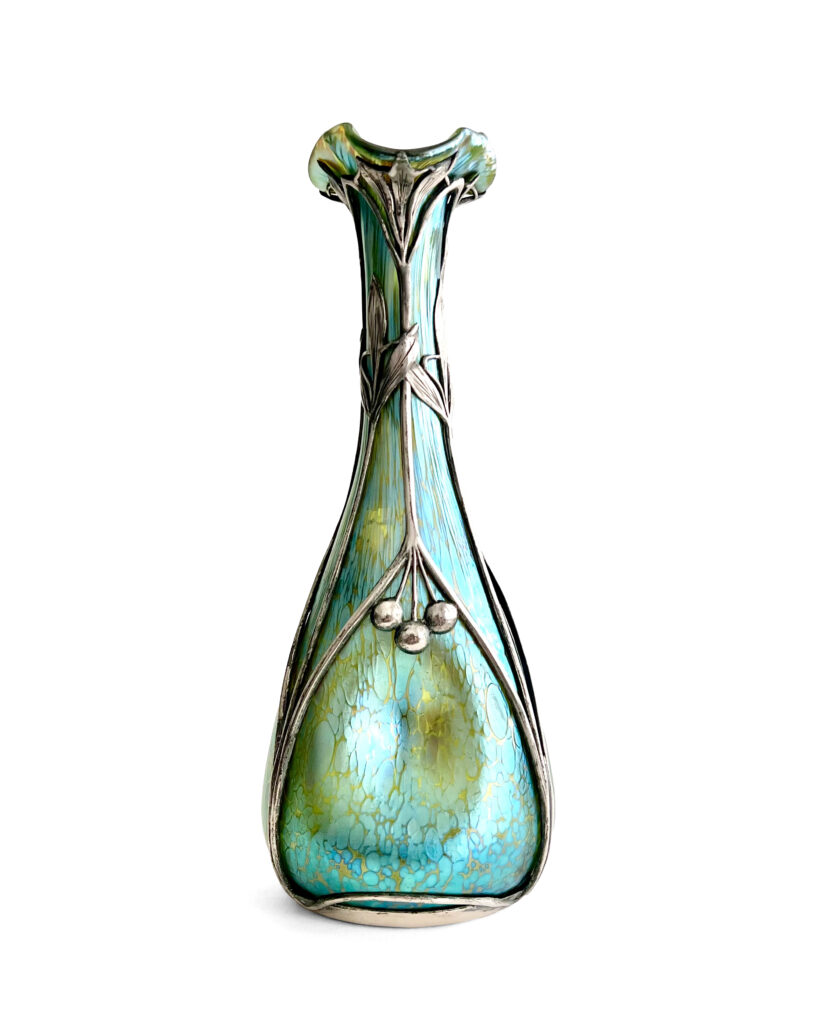
Johann Loetz Witwe / Moritz Hacker – Mounted ‘Papillon’ Vase
Austrian, circa 1900
Glass and silvered metal
A fine & rare Art Nouveau iridescent glass vase of dimpled bottle form with frilled rim. Decor from Loetz’s ‘Crete Papillon’ series of green glass with iridescent oil spotting. The silvered metal mounts, in the form of delicate fruit & foliage, created by Austrian metal worker / silversmith Moritz Hacker. Unsigned. Polished pontil mark.
Moritz Hacker (1849-1932) was a Hungarion born metal worker / silversmith working in Vienna in the late 19th and early 20th centuries. He created lamps and other metal decorative objects in the Art Nouveau style. For a brief time he collaborated with Loetz to create beautiful metal mounts on their glass pieces. These pieces are quite rare in the market and very sought after.
H 24cm. Base 9cm diameter. Rim 6cm diameter
$6,945
BELLE EPOQUE FINE ART GUEST
Arthur Boyd (1920-1999) – Rocks At Shoalhaven
1982
Australia
oil on board
Boyd is a famous Australian artist. He was recognised on the International stage from the mid to late 20th century, with work ranging from impressionist renderings of Australian landscape to starkly expressionist figuration. He is one of the highest valued Australian artists, and is represented in all major National Galleries in Australia and in the UK. His renowned ‘Bride’ series paintings regularly fetch over $1million per work. Boyd was a member of the Antipodeans, a group of Melbourne painters that also included Clifton Pugh, John Brack, Robert Dickerson, John Perceval and Charles Blackman. He is also part of the Boyd family artistic dynasty that includes painters, sculptors, architects and other arts professionals. This incredible piece is one of the finest examples of his ‘Shoalhaven’ series, a series which lasted from the early 1980s until his death, painted on his property in Bundanon as payment for a legal bill, and comes with esteemed provenance.
45.5 x 30.5cm
Savill Galleries, 1999
$120,000
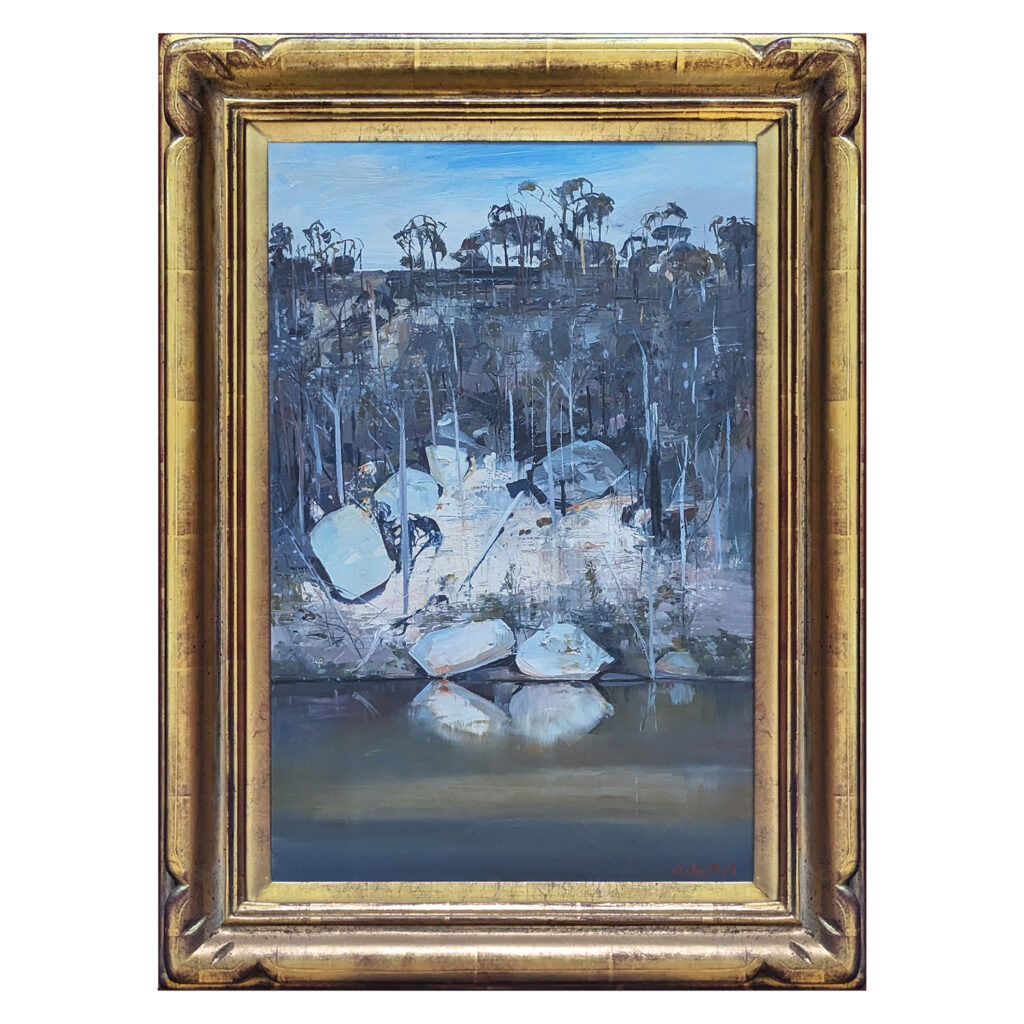
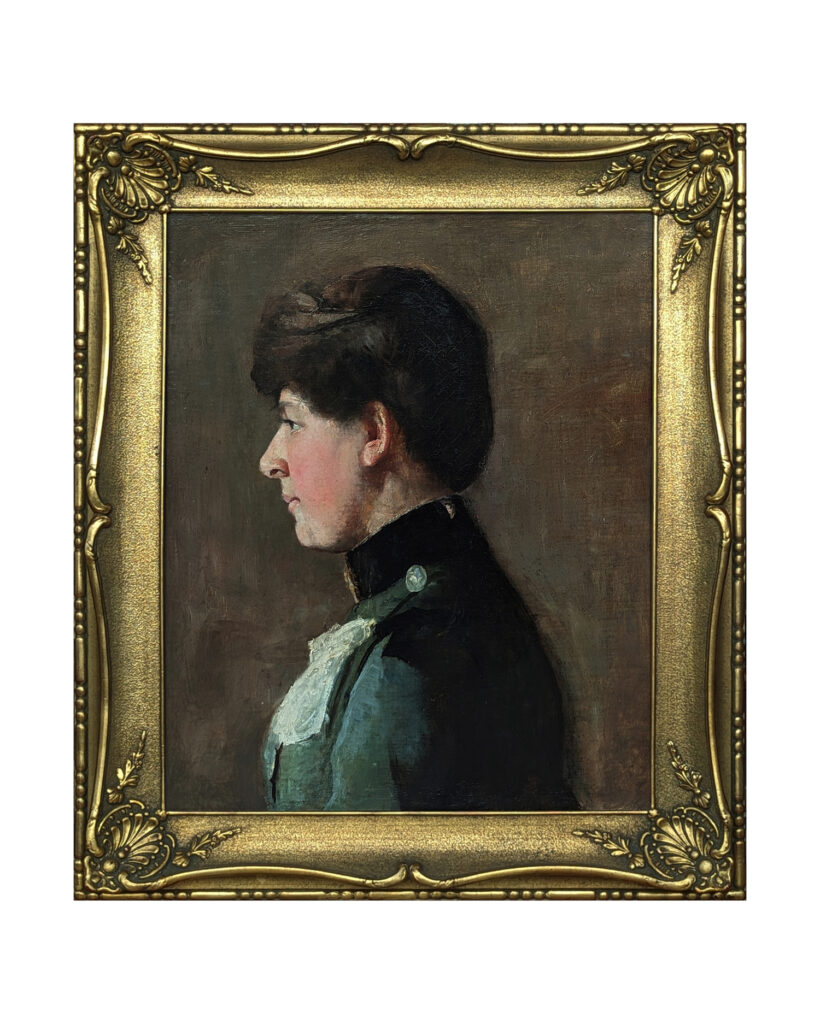
BELLE EPOQUE FINE ART GUEST
Tom Roberts (1856-1931) – “Portrait Of Annie Peirson”
1890
Australia
oil on canvas laid on board
Roberts is a famous Australian Impressionist. He was a leading figure & had a profound impact on the Heidelberg School, a group of more than 20 Australian impressionist painters who used impressionistic techniques & promoted painting outdoors or en plein air that flourished from around the 1880’s to early 1900’s. Roberts artwork displayed his feelings of ‘nationalism’ especially in the portraiture & outback paintings he produced, he saw these themes as a defining characteristic of modern Australian art. His artworks are noted for its tonal techniques of portraying the uniquely Australian light. Roberts travelled extensively & visited many remote outback stations, he visited Brocklesby station in the Riverina where he painted ‘Shearing the Rams’, which came to be considered the definitive image of an emerging national identity. In 1901 Roberts was commissioned to paint a vast representation of the opening in Melbourne of the first Federal Parliament of Australia “The Big Picture” completing the work in England in 1903. His works are iconic, & commonplace in all major National & Regional Collections!!
This impressive portrait depicts Annie Marion Peirson (nee Hendrickson) (1872-1957). Peirson was a student of the National Gallery School. The painting was passed to her sister, Christina, & passed down her family; the influential Grant-Hay family, known brewers, pastoralists & horse breeders. It was authenticated by Dr Helen Topliss, who produced Roberts’ Catalogue Raisonné in 1985.
52 x 41.5cm
Peirson/Grant-Hay Family Collection, Thence by descent / Masterpiece Fine Art, TAS
$80,000
BELLE EPOQUE FINE ART GUEST
Sydney Long (1871-1955) – “Moonlight, Narrabeen Lakes”
1944
Australia
oil on board
Long is an influential, pioneering Australian Symbolist. Originally inspired by the Heidelberg School of Australian impressionism, Long developed his own Symbolist approach to the Australian landscape, and by the 1910s had become Australia’s foremost Art Nouveau painter. Long began formal art classes at the New South Wales Art Society in 1890. In 1894 his Heidelberg School-influenced painting, a bathing scene set on the Cooks River By Tranquil Waters (1894) caused a small scandal, but was purchased by the Art Gallery of New South Wales. The sale brought Long to the attention of Julian Ashton, a Trustee of the Gallery and founder of the influential Julian Ashton Art School (at that time called the Sydney Art School), & in 1907 he became Ashton’s second-in-command in the school. In 1898 he was briefly engaged to Thea Proctor. In 1910 he moved to London, where he learned etching and became an associate of the Royal Society of Painters, Etchers & Engravers. He returned to Australia in 1921 & helped found the Australian Painters, Etchers & Engravers Society, lived in England for the period 1922–1925, then returned once more to Australia, becoming President of the Society. From 1933 – 1949 he was a Trustee of the Art Gallery of New South Wales. He won the Wynne Prize twice; in 1938 for The Approaching Storm, & in 1940 for The Lake, Narrabeen. He remained a director of the Society for many years, as well as remaining an active art teacher. His works are represented in most major collections, most notably AGNSW.
44.5 x 54.5cm
Private Collection, Melbourne / Lawsons 22/03/1990 No.201
$40,000
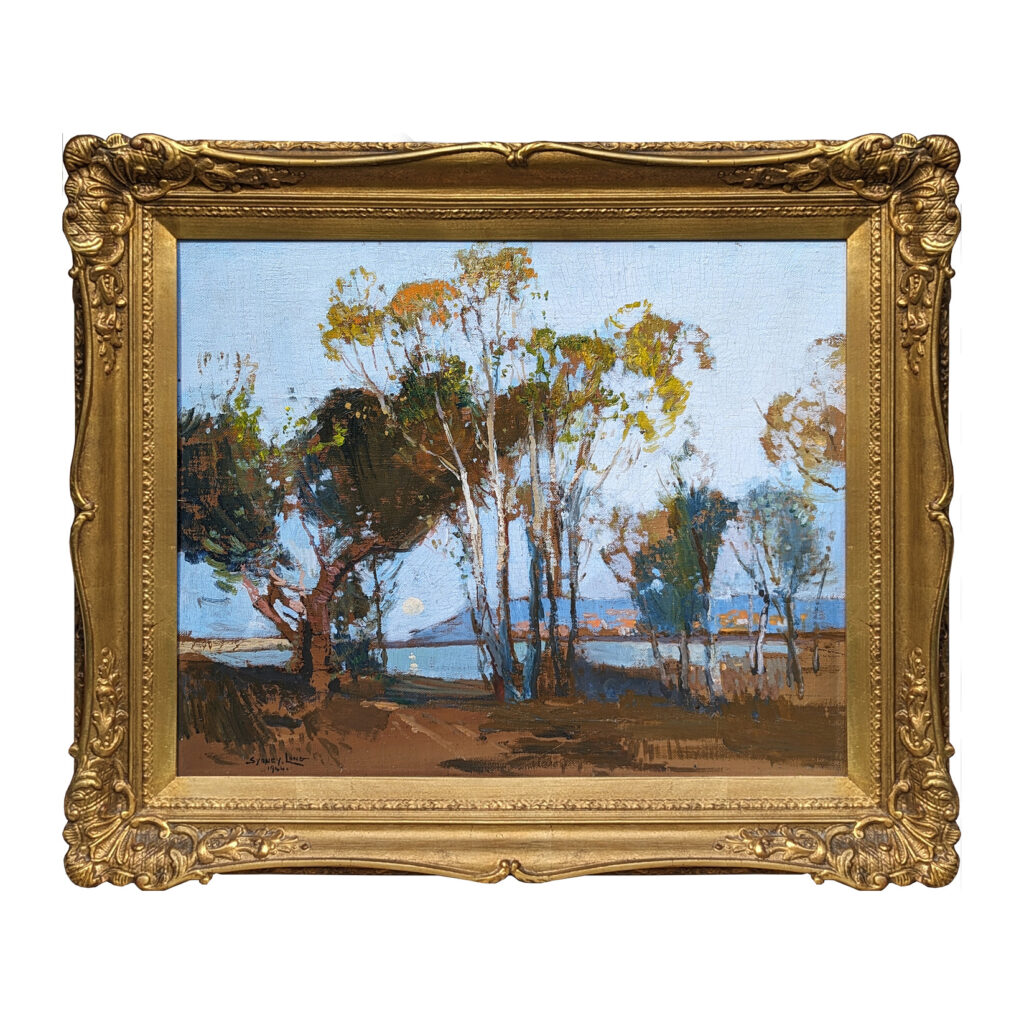
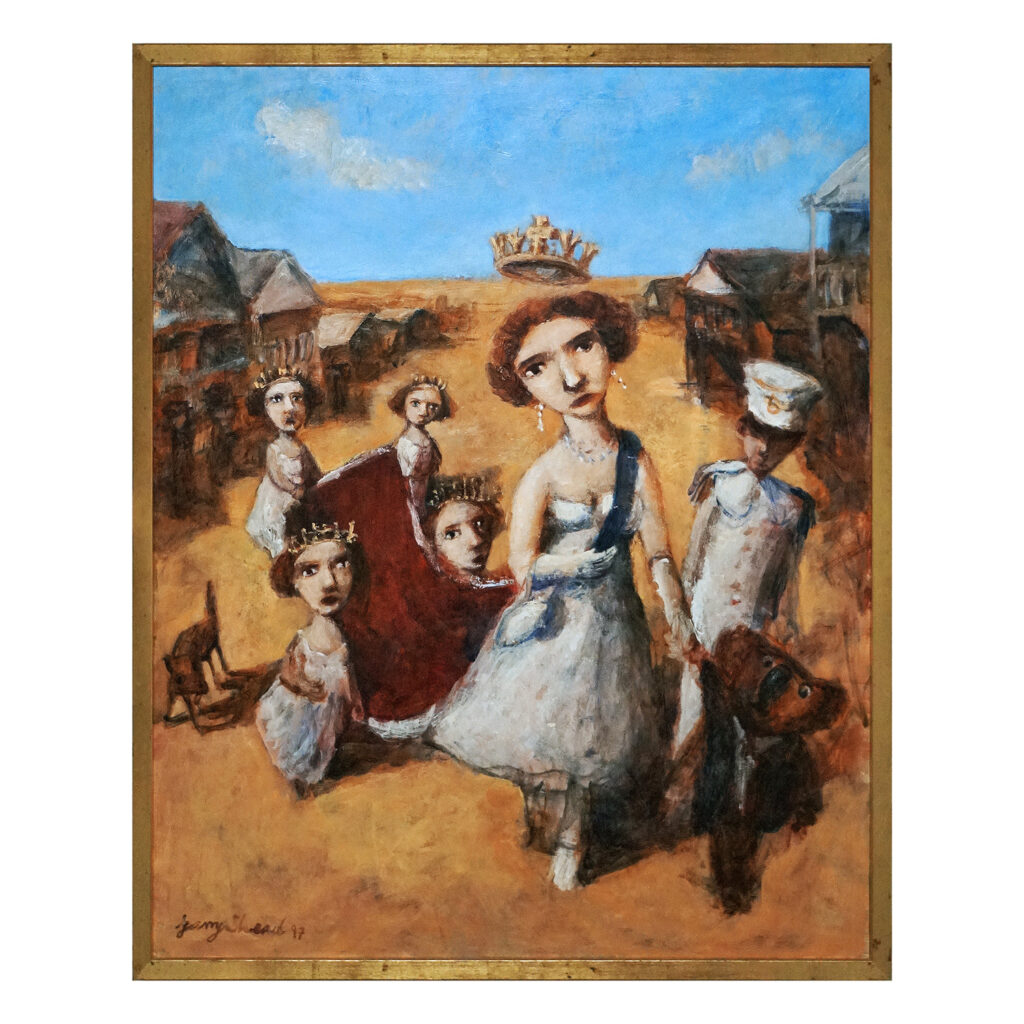
BELLE EPOQUE FINE ART GUEST
Garry Shead (1942-) – “Royal Visitors”
1997
Australia
oil on board
Shead is an award-winning painter, filmmaker, cartoonist and Archibald and Dobell Prize winning artist. He studied at the National Art School before establishing himself as one of Australia’s most respected and sought after contemporary & figurative painters. He has created many celebrated series of paintings including the ‘Royal Suite’ and the ‘DH Lawrence’ series. His work is represented in most major public collections in Australia, particularly the Art Gallery of NSW. This stunning original oil comes from his “Royal Suite”, and was illustrated in Sasha Grishin’s “Encounters With Royalty” (1998) publication.
76 x 61cm
Savill Galleries, 1998
$90,000
BELLE EPOQUE FINE ART GUEST
Lewis Morley (1925-2013) – “Christine Keeler”
1963 (1994)
England
limited edition platinum print, ed. 12/25
Morley is a famous, influential British Photographer and Artist. He was best known for his artistic, surrealist portraits of actors, models and artists. His photo of model Christine Keeler is one of the most iconic fashion & political photography moments of the 20th century. He was a significant British mid-century artist, in a new wave of contemporary artists emerging in the 1960s alongside David Hockney, Peter Blake & R.B. Kitaj. In 1961, Christine Keeler was an unknown, 19yo British model & showgirl, when she was embroiled in a high profile sex scandal with John Profumo, the British Secretary of State for War, & Soviet naval attaché Eugene Ivanov. Pressure from Fleet Street forced Profumo’s resignation, drove Stephen Ward to suicide, Keeler was imprisoned, – the Government was brought into chaos & disrepute; a precursor to the Bill Clinton/Monica Lewinsky scandal. Morley photographed Keeler in his studio above The Establishment at the behest of Peter Cook as publicity shots for a future film, Profumo Scandal, which was not released in the UK. As Morley has noted: “My own driving force has always been more emotional than intellectual and so the Sixties was also my period in that sex became the great leveller.”
This RARE iconic, hand-signed & numbered platinum print on Arches paper was produced in 1994, & limited to 25 prints.
45.5 x 35cm (76 x 56cm sheet)
Private Collection, Gold Coast
$40,000
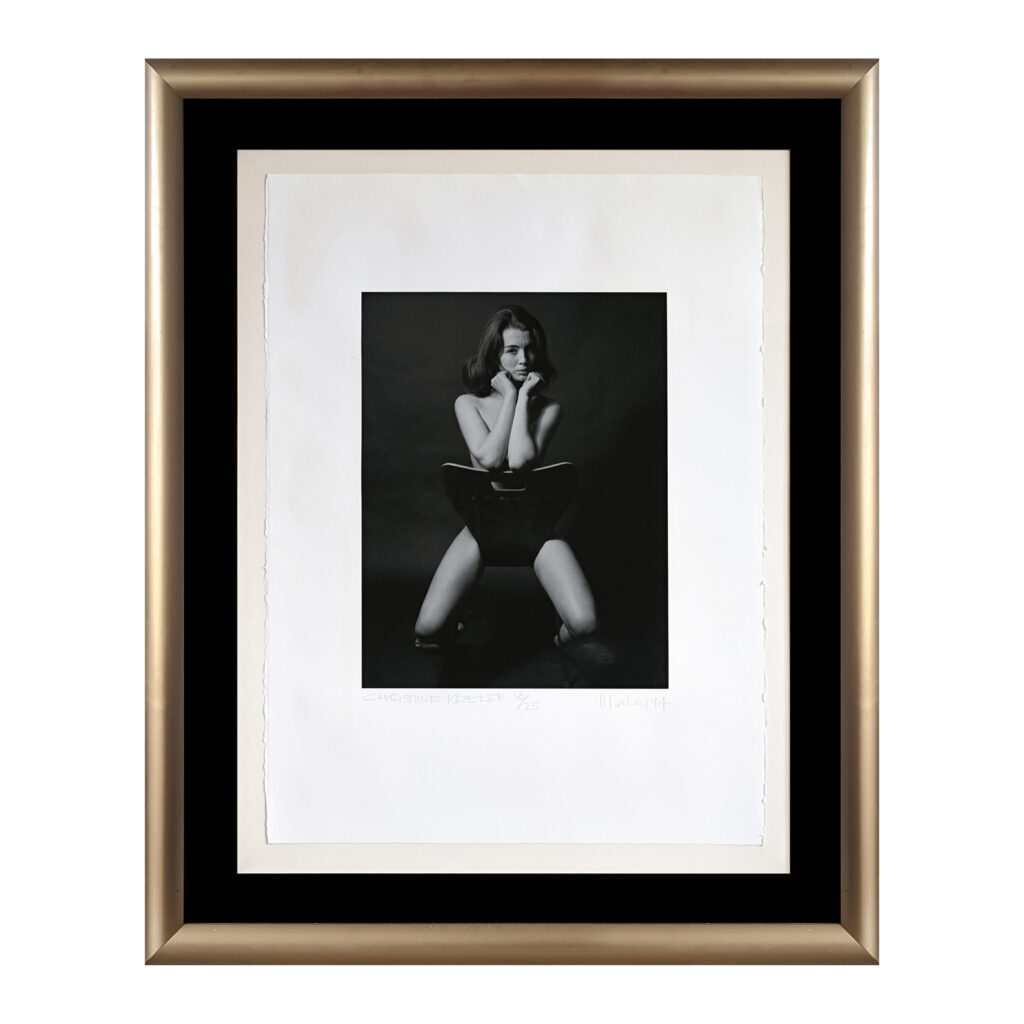
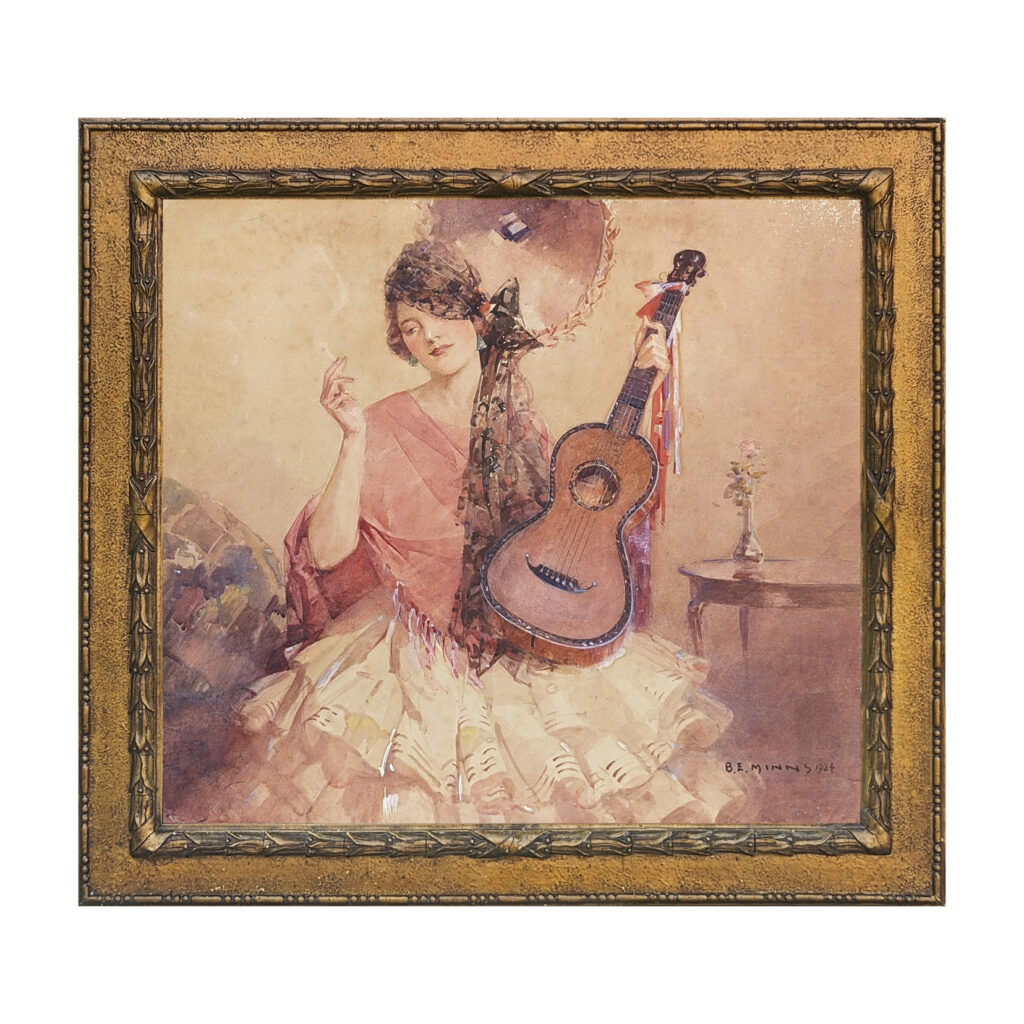
BELLE EPOQUE FINE ART GUEST
Benjamin E. Minns (1863-1937) – “The Cigarette”
1924
Australia
watercolour
Benjamin Edwin Minns was an Australian artist, recognised as one of Australia’s foremost watercolourists. He was born in Dungog, New South Wales, Australia and had lessons in painting and drawing at Inverell, New South Wales. Intending to have a career in law, Minns went to Sydney and worked for the law firm Abbot & Allen. However, he met the artist Charles Conder with whom he shared a studio. Minns then studied under Lucien Henry at Sydney Technical College, also taking lessons from the plein air painter Julian Ashton.
Minns obtained his first job at the Illustrated Sydney News with Conder’s help; Minns also drew for the Sydney Mail and regularly contributed to The Bulletin. From 1895 to 1915 Minns worked in England, contributing to St Paul’s Magazine, Punch, The Strand Magazine, the Bystander and other publications as well as sending drawings to The Bulletin. Minns was a founder in 1924 and inaugural president (until 1937) of the Australian Watercolour Institute.
Minor losses upper right
52 x 57cm
Society Of Artists Exhibition, 1924
$35,000
BELLE EPOQUE FINE ART GUEST
Ludovico Marchetti (1853-1909) – “Gabrielle Cot”
1891
Italy
oil on canvas laid on board
Marchetti was a prominent Italian Romantic & Genre painter. He trained under Spanish Realist Master, Mariano Fortuny y Marsal who had a studio in Rome during the early 1870’s. By 1878, at the age of 25, Marchetti left for France. Here he continued his studies and began exhibiting at the Paris Salon, as well as exhibition halls in Berlin and Munich. Like many of his contemporaries, Marchetti specialized in historic paintings – scenes from the bygone era. Among his favorite subjects were the cavaliers and troubadours of the 18th century – dressed in there richly colored clothes. Marchetti would have known Bouguereau as they were both in Paris at the same time sharing the same dealer, Adolphe Goupil. The portrait is of Pierre Cot’s (another well known artist) daughter and was given as a wedding present. It was the only non-commissioned work Bouguereau ever did and was kept inside the family until 1983. It was only exhibited once to the public at the Paris Salon in 1891, where Marchetti would have seen it as he was a regular Salon exhibitor, unless Bouguereau or Cot gave him a private viewing. The original sold for $AU300k in 2011.
60 x 50cm
Private Collection, Sydney
$20,000
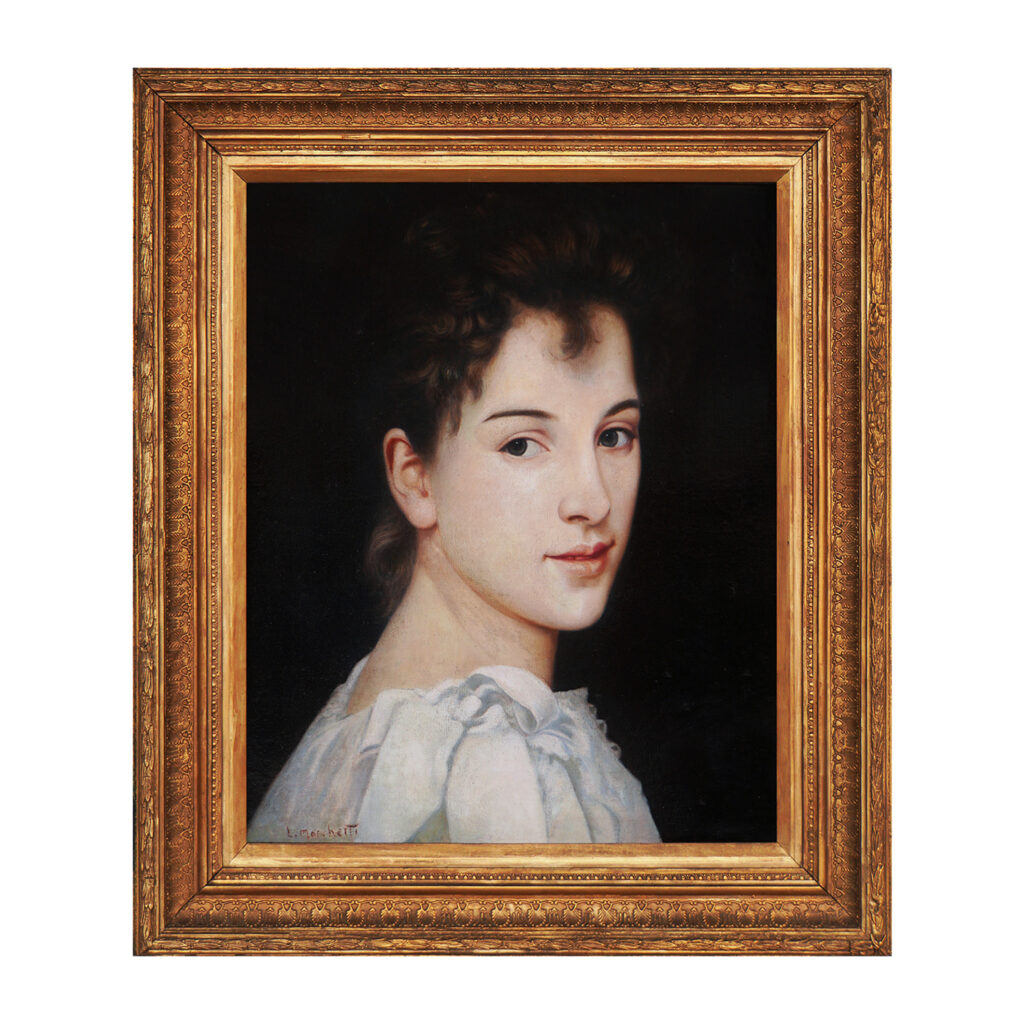
BELLE EPOQUE FINE ART GUEST
Frances Hodgkins (1869-1947) – “Old Street In Dinan”
1902
New Zealand / France
watercolour & bodycolour
Hodgkins was one of New Zealand & Britain’s most prestigious, pioneering, decorated and influential artists. Trained at the Dunedin Art School and under Girolamo Nerli, before moving to London in 1901. She was the first New Zealand artist to be hung in the Royal Academy in 1903, and held her first solo show in London in 1907. In 1908, she was the first woman to work as an art instructor at the famous Colarossi’s Academy in Paris, exhibited regularly at the Paris Salon and even established a School Of Watercolour. After the War, she worked between France & Britain and worked with/influenced up-and-coming British artists, Barbara Hepworth, Ben Nicholson & Henry Moore. She was highly considered among British avant-garde society and by the later stages of her career was known as a key figure in British Modernism.
36 x 26cm
Collection of W.G.H.Field, Waikanae / “Works Of Frances Hodgkins In New Zealand” (Auckland City Gallery, 1954) No.178
$120,000
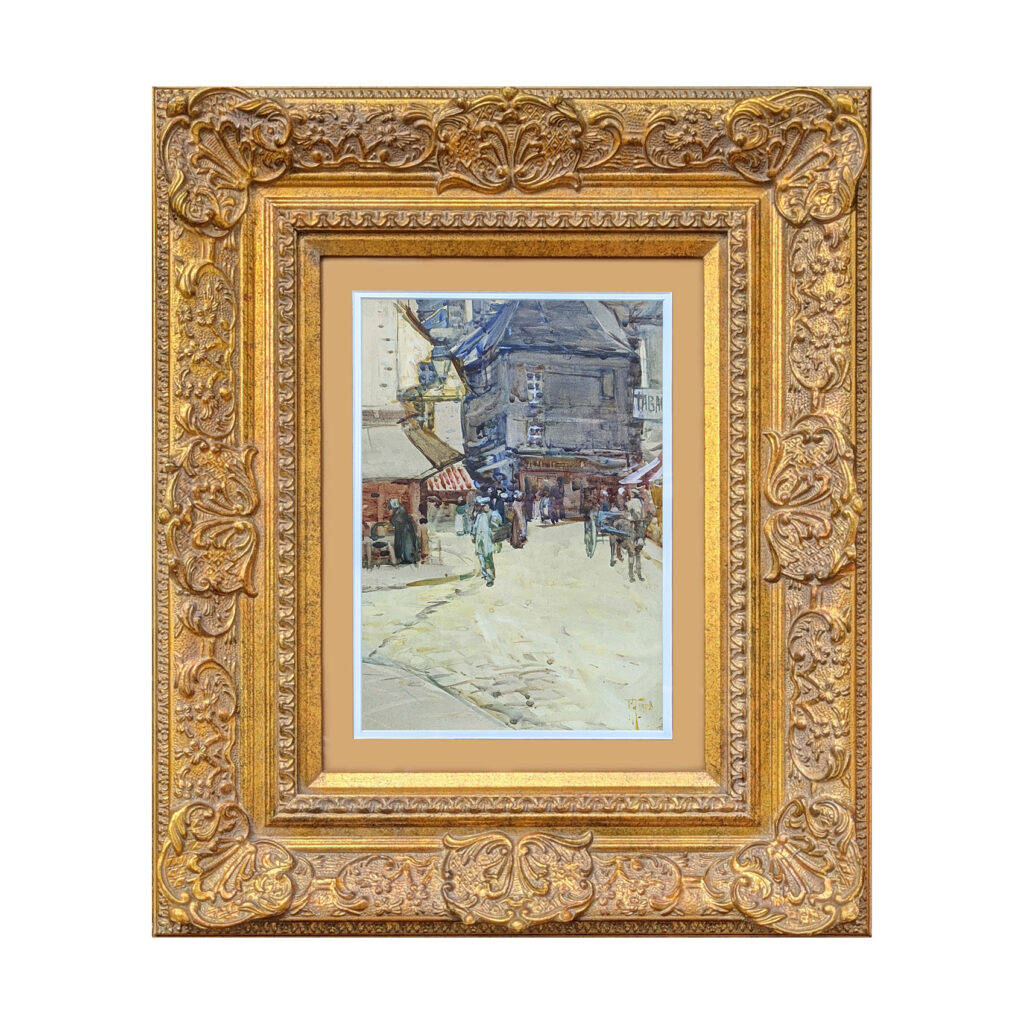
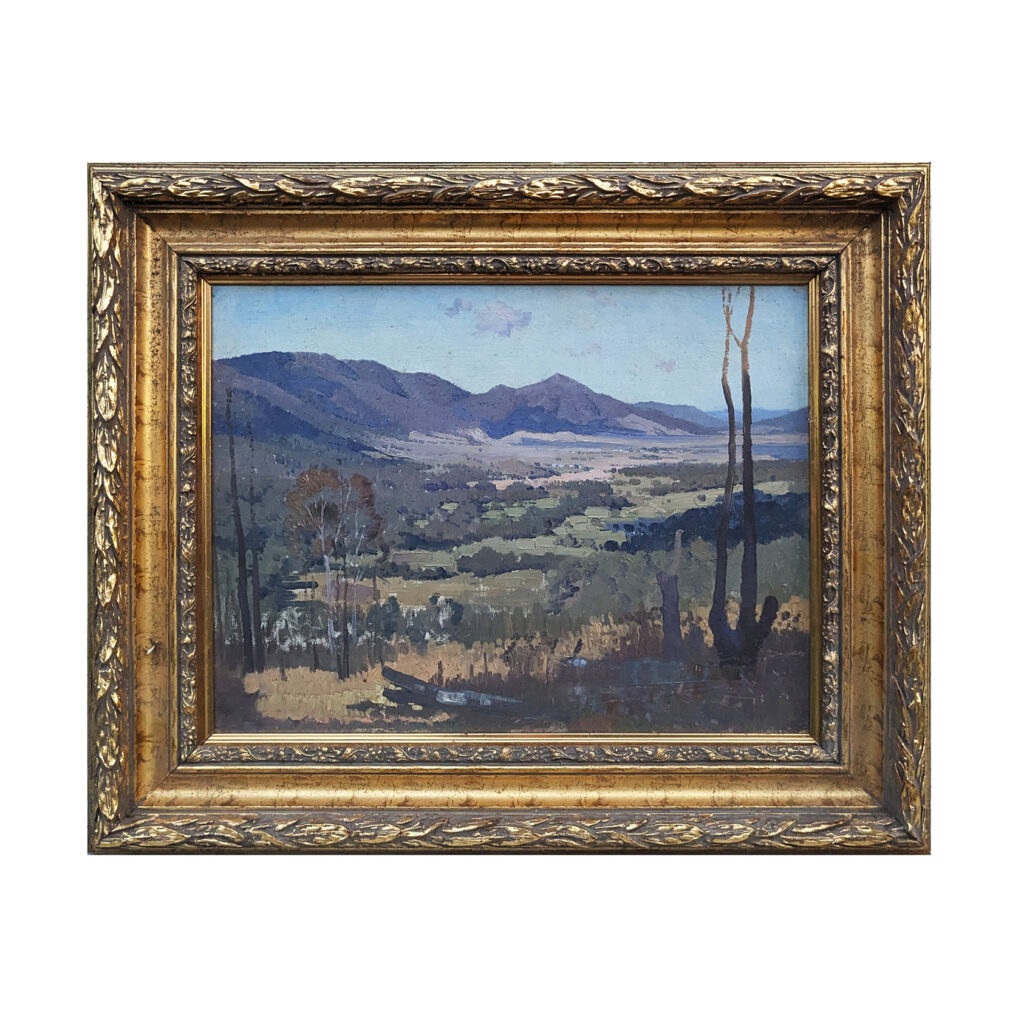
BELLE EPOQUE FINE ART GUEST
Elioth Gruner (1882-1939) – “Study For Happy Vallery Araluen”
1922
Australia
oil on card, laid on board
A successor of the plein air Heidelberg School tradition in Australian art, Gruner is known for his high-key impressionist landscapes & his ability to capture the ephemeral effects of light. According to Norman Lindsay, he “painted the purest light that ever has been seen on a bit of canvas”. Gruner began attending art classes with Julian Ashton from around the age of twelve. He exhibited for the first time, with the Society of Artists, in 1901, with a still-life painting. He preferred to paint landscapes when he was able to paint outdoors en plein air, in the manner of the Impressionists he so admired. In 1916 Gruner finally achieved critical success with the painting ‘Morning Light’ which was awarded the Wynne Prize, and purchased by the AGNSW. The painting was popularly proclaimed to be the artist’s masterpiece. He won the Wynne Prize seven times, ‘Spring Frost’ won in 1919, & his preference for painting green, rolling pastures & farmyard animals made him one of the most popular artists of his day. While he was to become an important figure in the Society of Artists, and the Australian painting scene generally, towards the end of his life, Gruner suffered from depression and alcohol dependency. He has been the subject of numerous retrospectives & is represented in all major National Galleries!
The finished oil, “Happy Valley, Araluen” (1922) is regarded as one of Gruner’s most important paintings, commissioned by the Union Club, Sydney, exhibited at the Society Of Artists Exhibition of 1922, & received significant national praise in contemporary print media. It remains at the Union Club to this day.
“The Happy Valley, Araluen”… is Gruner’s final attempt to give spacious treatment to our wide landscape. In the treatment of light, he has a subtle touch, and no one knows better how to picture the luminous quality that is even in our shadows on a brilliant summer day.” – Sydney Mail
34 x 44cm
Gift of Artist, thence by descent
$65,000
BELLE EPOQUE FINE ART GUEST
Henry Edgecombe (1881-1954) – “St. Mary’s Basilica”
1937
Australia
oil on canvas
Edgecombe was a prolific Australian artist and six-time Wynne Prize finalist. Edgecombe was a member of the Royal Art Society and commitee member of the Australian Watercolour Society. He was known for his impressive landscapes and cityscapes of Sydney and the East Coast of Australia. His works are represented in several major institutions such as the New England Regional Art Museum. St. Mary’s Cathedral is one of Australia’s greatest colonial architectural achievements, designed in the Gothic Revival style by the iconic English architect, Augustus Pugin, in 1868 and modifications continue to present day. Edgecombe was a member of the Royal Art Society and commitee member of the Australian Watercolour Society, this impressive oil of was originally donated to the Catholic Church by Edgecombe himself.
61 x 76cm
Gift of the artist to St. Mary’s / Private Collection, Sydney
$15,000.00
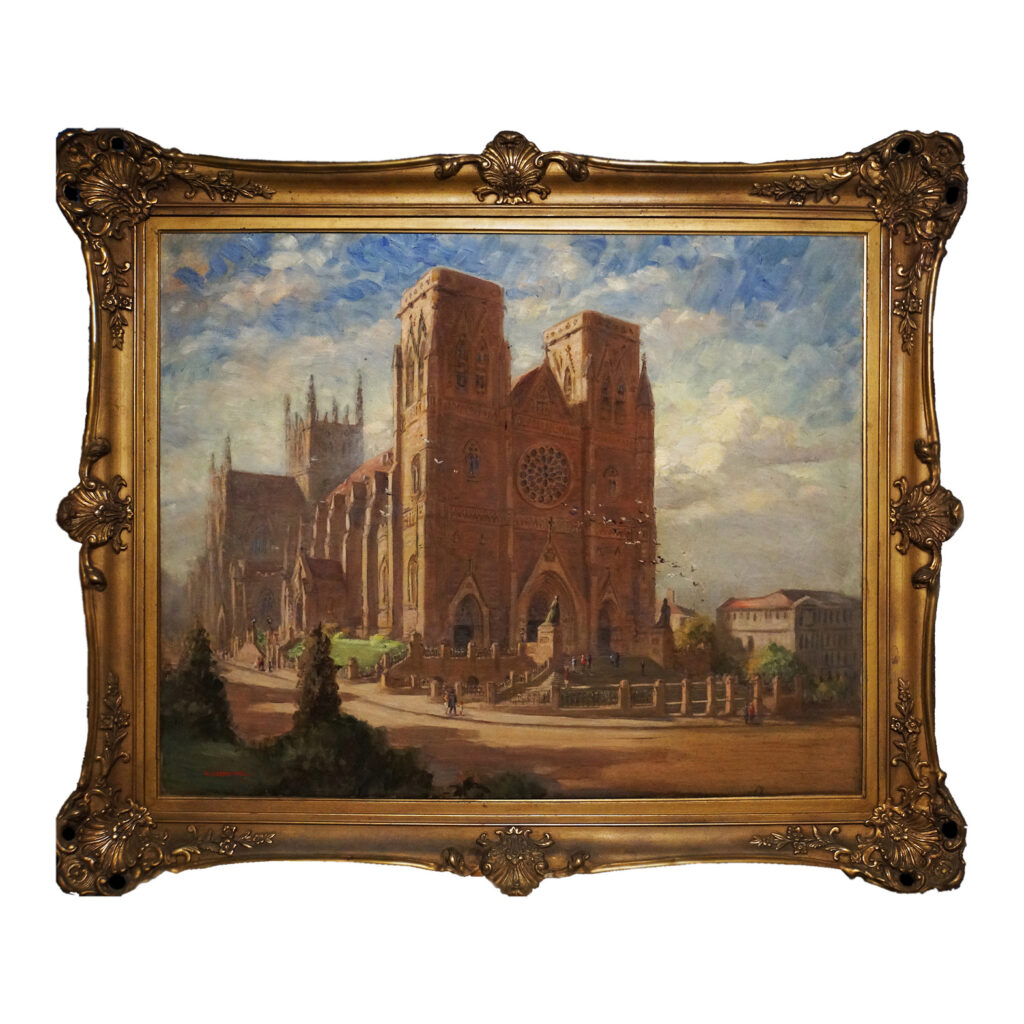
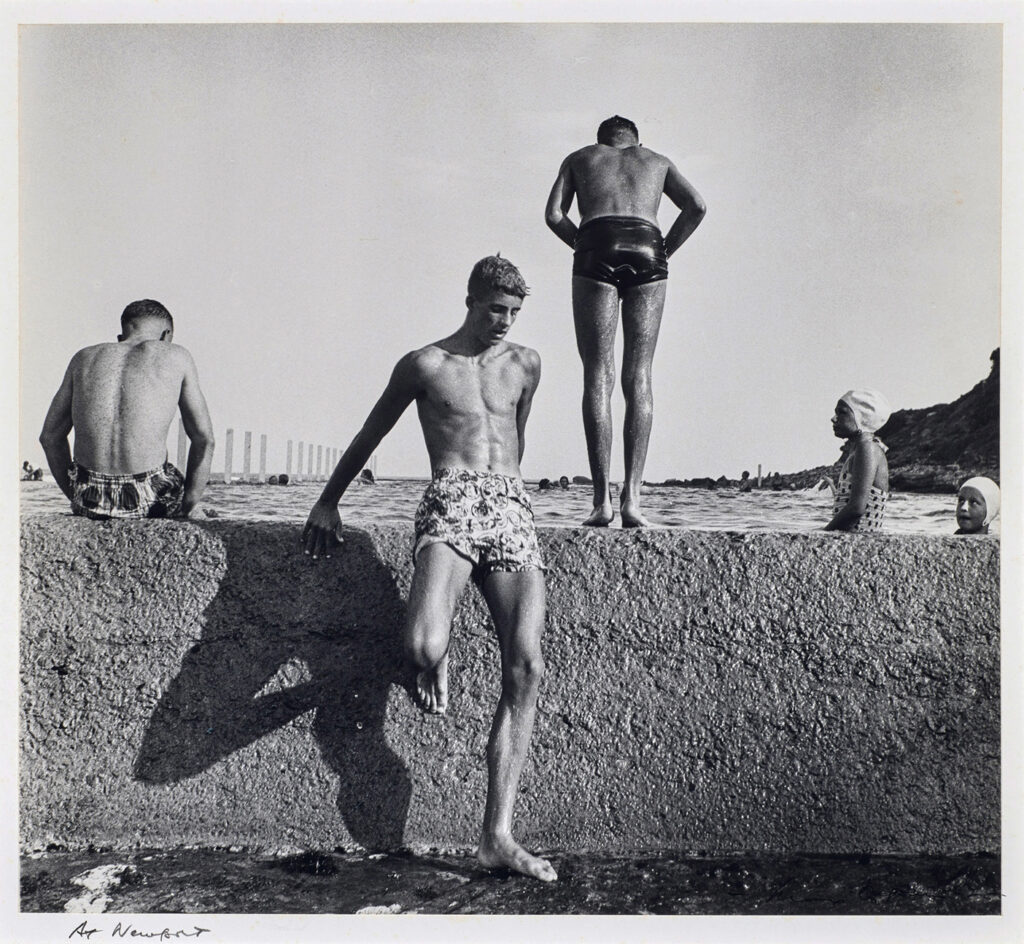
BELLE EPOQUE FINE ART GUEST
Max Dupain (1911-1992) – “At Newport”
1952
Australia
silver gelatin photograph
Dupain is arguably Australia’s Greatest Photographer. Born in Sydney, Dupain received his first camera as a teenager and trained with photographer Cecil Bostock while working as his assistant. After setting up his own studio in 1934, Dupain established his reputation with portraiture and advertising work, gained exposure in the lifestyle magazine The Home, and photographed ballet dancers for the ABC, including dancers from the Kirsova Ballet and the three Ballets Russes companies that toured Australia between 1936 and 1940. While Dupain was on service during the Second World War, he briefly worked for the Department of Information from 1945 to 1947, photographing Australia for propaganda purposes. His then-wife Olive Cotton, one of very few professional women photographers in Australia, ran his studio. In the 1950s Dupain turned increasingly to architectural photography, collaborating in particular with architects Samuel Lipson, Sydney Ancher and Harry Seidler. From 1958 to 1973 he documented the construction of the Sydney Opera House. During the same period, he began photographing historic properties for the National Trust and recorded Canberra’s new buildings for the National Capital Development Commission. In 1975 the Australian Centre for Photography mounted the touring exhibition Max Dupain: A Retrospective 1930–1975. This show brought Dupain’s name to the attention of the wider public, and turned The Sunbaker, taken nearly 40 years earlier, into a definitive Australian image. This original, silver gelatin photograph is hand-signed & annotated by Dupain, and comes direct from the artist’s estate!!
30.5 x 34cm
Estate Of The Late Max Dupain
$30,000
BELLE EPOQUE FINE ART GUEST
Pavel Chmaroff (1874-1950) – “Plyzah (Beach)”
1920
Russia / France
oil on board
Pavel Chmarov was a famous, award-winning Russian Impressionist, known as the ‘Renoir Of Russia’. He was born in Voronezh to a poor peasant family in 1874. In 1893, he went to study at a free art school run by L. G. Solovyov, where drawing and open air sketches were emphasised. The following year he was admitted for graduate studies at the Imperial Academy of Art. In the workshop led by the famed Ilya Repin, he became acquainted with Malyavin, Kustodiev & Ostroumova-Lebedeva. In 1899, he received a gold medal, the official title of ‘artist’, a government stipend & a scholarship to pursue his studies abroad. He travelled to Vienna, Rome, Florence, Venice and Munich. In Munich, he studied at the art school of Anton Aschbe along with Borisov-Musatov. In 1904, he was awarded a gold medal at the International Exhibition of St. Louis. Chmarov displayed his works at the Academy of Fine Arts. Between 1900-10, he made a series of portraits of aristocrats, industrialists & prominent figures, as well as of the Czar Nicholas II & other members of the imperial family. He was appointed a court painter. He painted large scenes of battles, & decorative panels, & created drawings for newspapers, designs for the theatre, & illustrations for the works of Nekrasov and Pushkin & Zabelin. In 1916, Chmarov was elected an academician of the Academy of Fine Arts. At the beginning of 1923, he left Russia for Rome & settled in Paris. He worked mainly on commission, painting portraits, landscapes with bathers or young peasant women in Russian costumes, imbued with nostalgia for his native land, as well as numerous still lifes. He participated in exhibitions of Russian art in Paris & various cities in Germany, England, Holland, Belgium, Argentina & Yugoslavia. During WWII, he moved with his family to Boulogne-Billancourt, where they became parishioners of the Orthodox Church of St Nicholas.
42 x 82cm
Private Collection, Lodz / Confiscated by Nazis 1942 / Returned by Polish Govt. 1947
$85,000
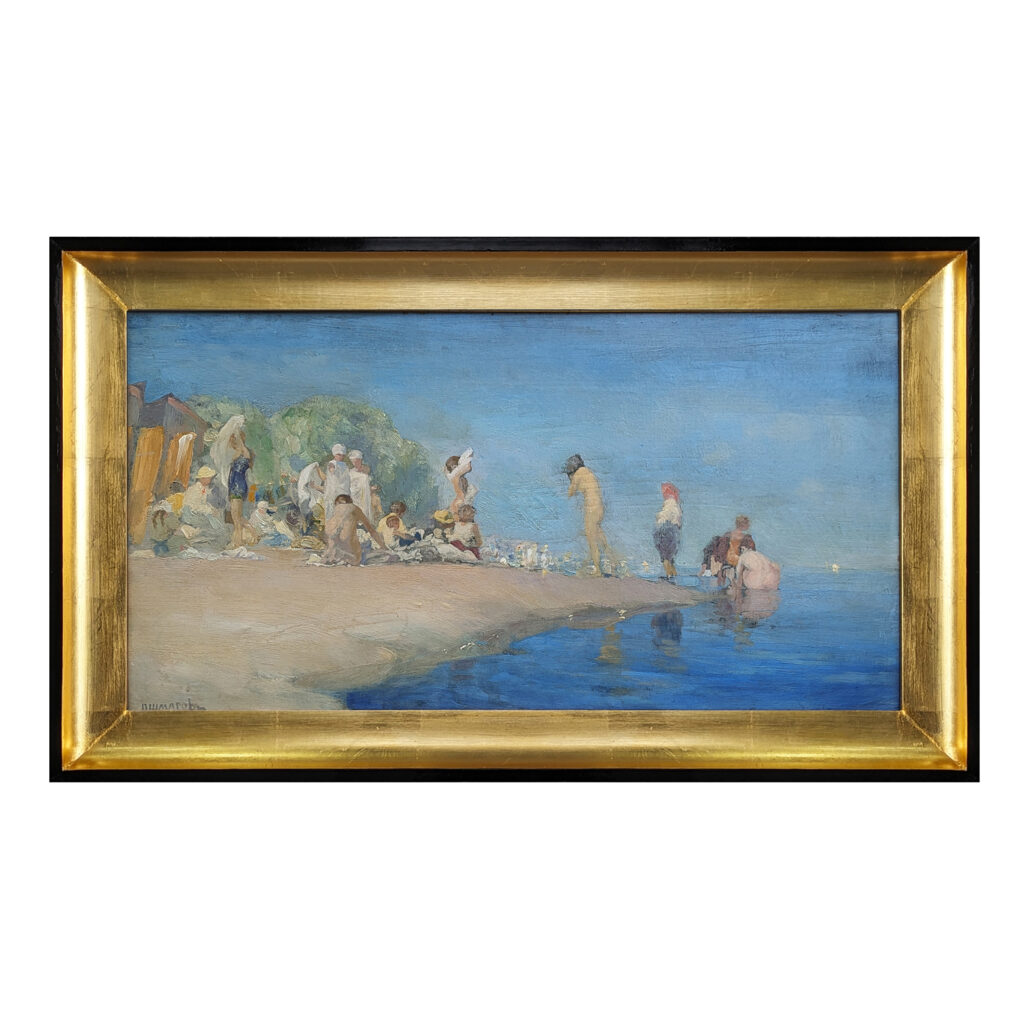
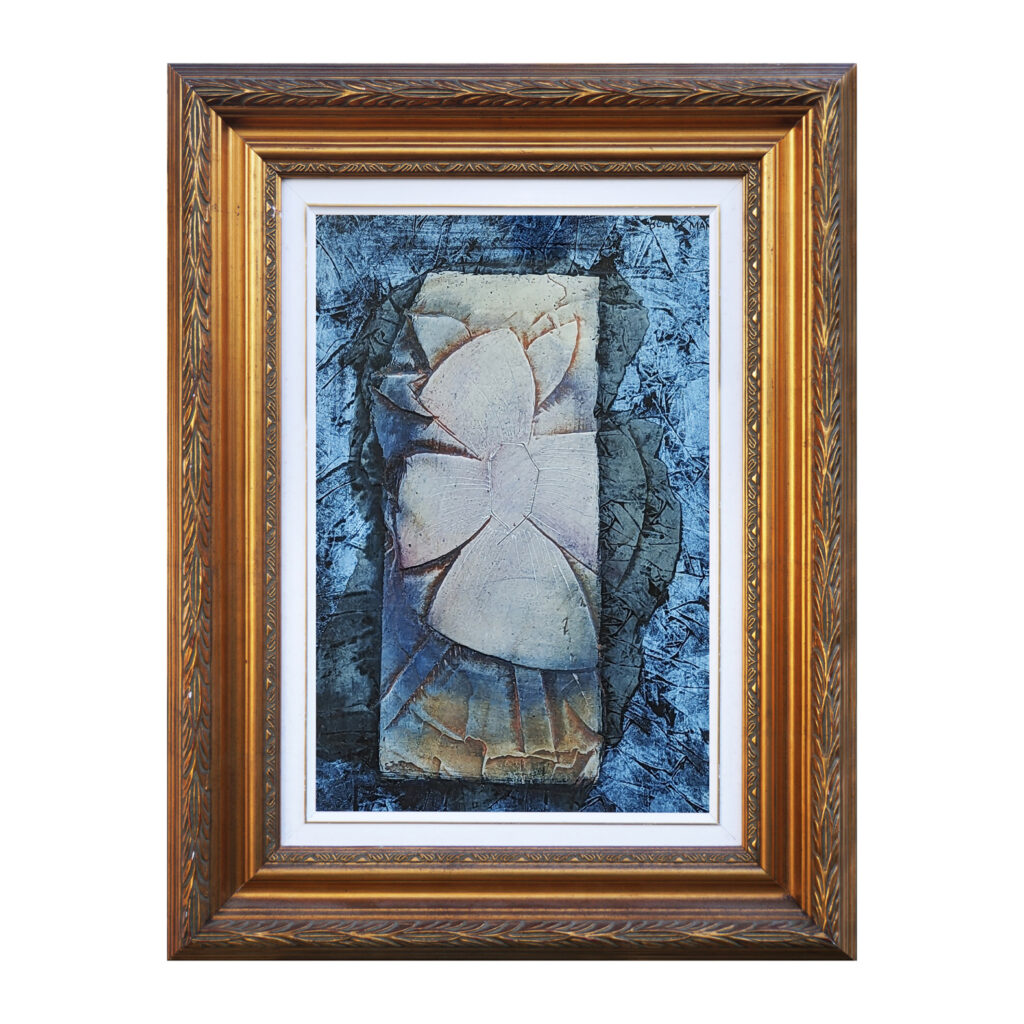
BELLE EPOQUE FINE ART GUEST
Charles Blackman (1928-2018) – “Rainforest Series”
1984
Australia
mixed media relief on board
Charles Blackman OBE was a famous Australian artist. He studied at East Sydney Technical College. He came to notice following his move to Melbourne in the mid-1940s, where he became friends with Joy Hester, John Perceval and Laurence Hope as well as gaining the support of critic and art patron John Reed. He was a member of the Antipodeans, a group of Melbourne painters that also included Arthur Boyd, David Boyd, John Brack, Robert Dickerson, John Perceval, and Clifton Pugh. His work met critical acclaim through his early Schoolgirl and Alice series, the latter Blackman’s conception of Lewis Carroll’s most famous character. These series are amongst the most valuable and highly sought after artworks in Australia, some selling for seven figures. His works are commonplace in most National Galleries.
45.5 x 30cm
Nadine Amadio Estate Collection
$30,000
BELLE EPOQUE FINE ART GUEST
Brett Whiteley (1939-1992) – “Study For Baudelaire’s Bird”
1973
Australia
mixed media on paper
Whiteley AO is Australia’s most famous and internationally renowned artist. He was a painter, printmaker & mixed media artist. He is represented in the collections of all the large Australian galleries, and was twice winner of the Archibald, Wynne & Sulman Prizes. He held many exhibitions, and lived and painted in Australia as well as Italy, England, Fiji and the United States. He tragically died prematurely of a drug overdose at the height of his popularity. His final studio in Surry Hills was converted into a gallery by the Art Gallery Of NSW and the Brett Whiteley Travelling Scholarship named in his honour. He is the highest valued and sought after Australian artist, and currently holds the record for the second, third and forth most expensive Australian paintings ever sold!!
This impressive, original mixed media study is extremely RARE!! It was part of a series of Bird studies based on the work of French poet, Charles Baudelaire, including “Baudelaire’s Bird” (1973) & Butcher Bird With Baudelaire’s Eyes” (1972). They were completed around the time he constructed his epic, self-portrait “Alchemy” (1972-73).
“David, Genius, is really knowing which remark it is that convince another person that one is in possession of genius. That’s all, in other words genius is the most sensitive of human discovered inventions”
The inscription is directed at his infamous friend and philosophical sparring partner, David Litvinoff. This work has been in a private collection for 30 years.
71 x 52cm
Bonython Gallery, 1973 / Lasseter’s Gallery, 1989
$85,000
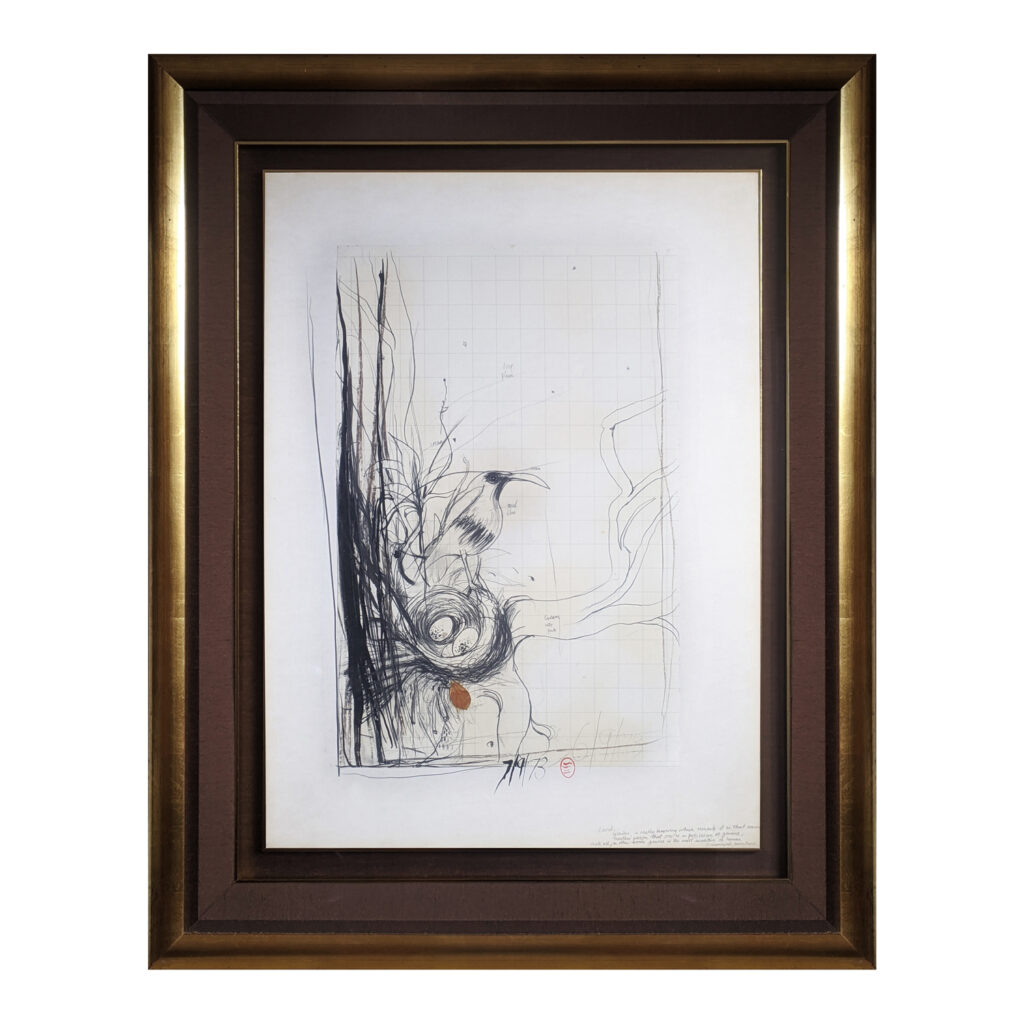
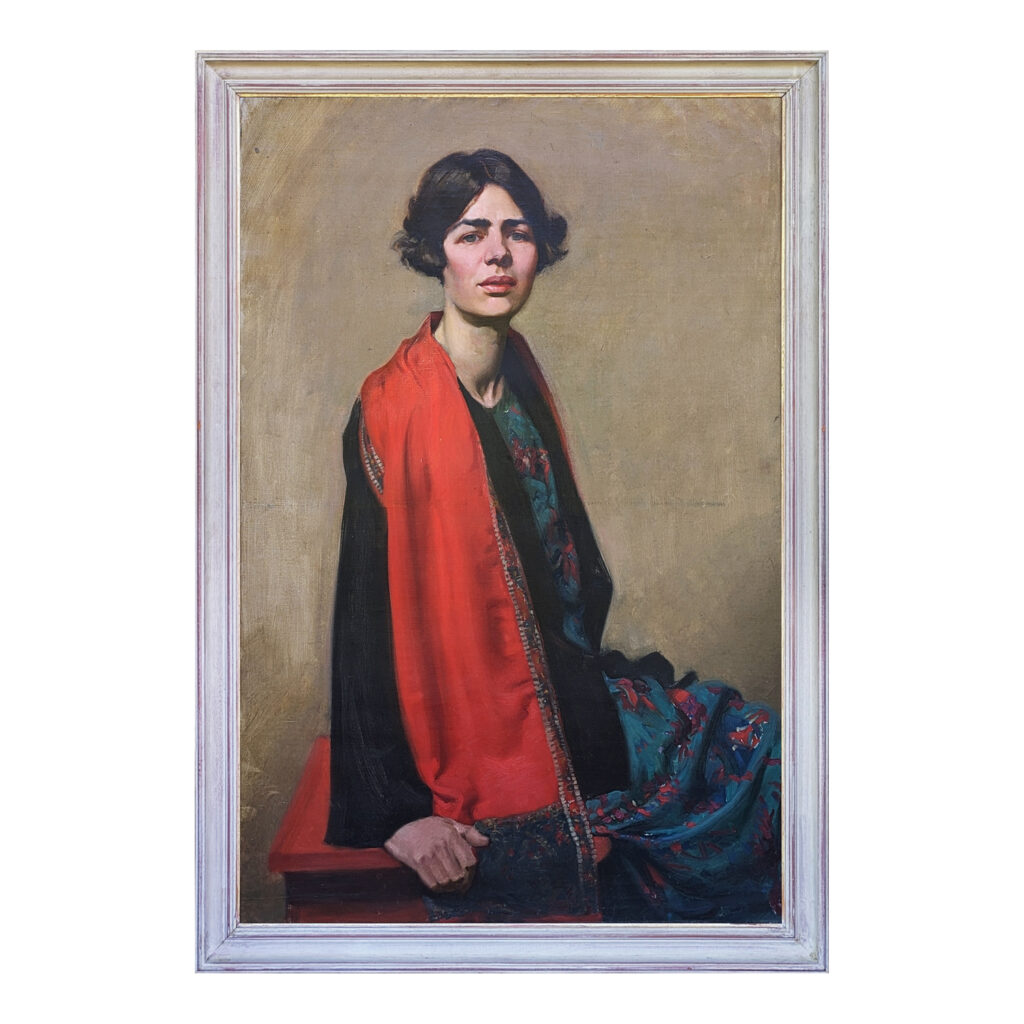
BELLE EPOQUE FINE ART GUEST
Jean Sutherland (1902-1978) – “Lady With The Scarlett Shawl”
1927
Australia
oil on canvas
Sutherland was an influential, award-winning Australian Modernist. She studied at Melbourne’s National Gallery of Victoria Art School, winning the prestigious Travelling Scholarship in 1923. In London, she enrolled in the Royal Academy Schools and briefly studied at the world-renowned Slade School of Art, travelling and painting throughout Europe. She returned to Australia in 1927, joining and exhibiting with the Victorian Art Society and the Melbourne Society of Women Painters, alongside friends and contemporaries Ethel Carrick Fox & Sybil Craig. In October 1944, she held her only solo show, with a collection of primarily still life watercolours, at Melbourne’s Sedon Galleries. Her works are in all most National gallery collections, particularly the NGV. This work was exhibited at Sutherland’s posthumous retrospective at Charles Nodrum Gallery in 1979.
111 x 73.5cm
Charles Nodrum Gallery, 1979 (artist’s estate)
$35,000
